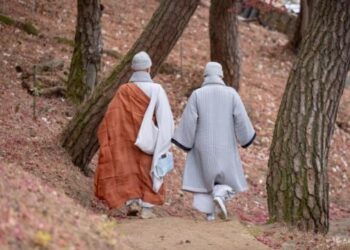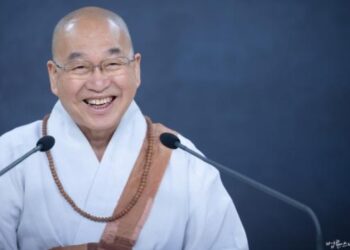Jul 16, 2025 – Visits to Kyungdong Church, Cheondogyo, Jogye Order, Anglican Church of Korea, and Dorasan Observatory
Hello. Today marks the third day of Sri Lankan religious leaders’ visit to Korea. They planned to visit various Korean religious organizations directly and have dialogues with each other.
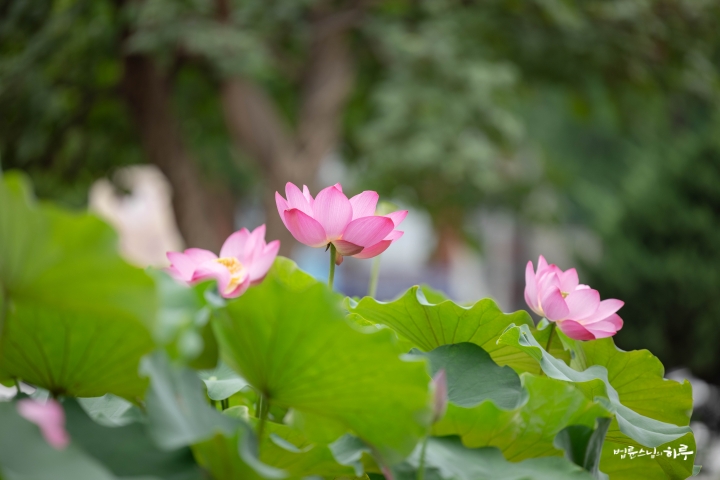
After completing morning practice and meditation, Sunim exchanged greetings with the Sri Lankan religious leaders. Before departure, Sunim briefly explained today’s schedule.
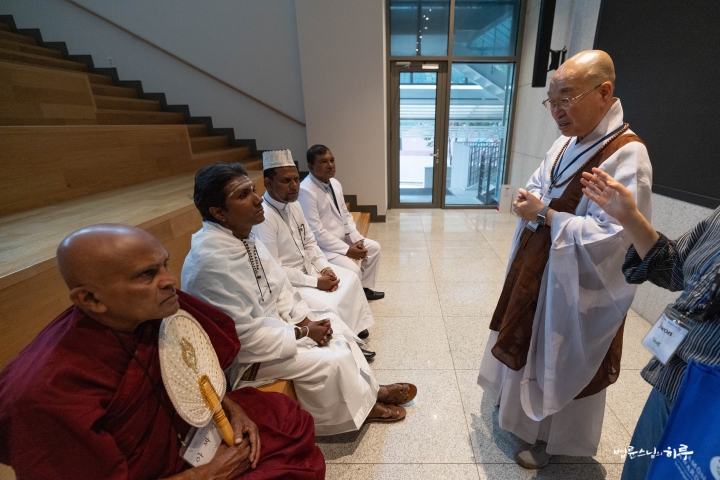
“The first place we’re visiting today is Kyungdong Church, which belongs to the Presbyterian Church in the Republic of Korea. Reverend Park Jong-hwa served as the senior pastor of Kyungdong Church for a long time. The second place is the Cheondogyo Central Temple. Mr. Park Nam-su served as the supreme leader of Cheondogyo. The third place is the headquarters of the Jogye Order, which represents Korean Buddhism. The fourth place is the Anglican Cathedral of Seoul. Bishop Park Kyung-jo served as the bishop of the Anglican Church of Korea. They were all once the highest leaders of their respective religions, but now they have retired due to their age. Well then, let’s depart.”
At 8 AM, they departed from Jungto Social and Cultural Center and headed to Kyungdong Church.
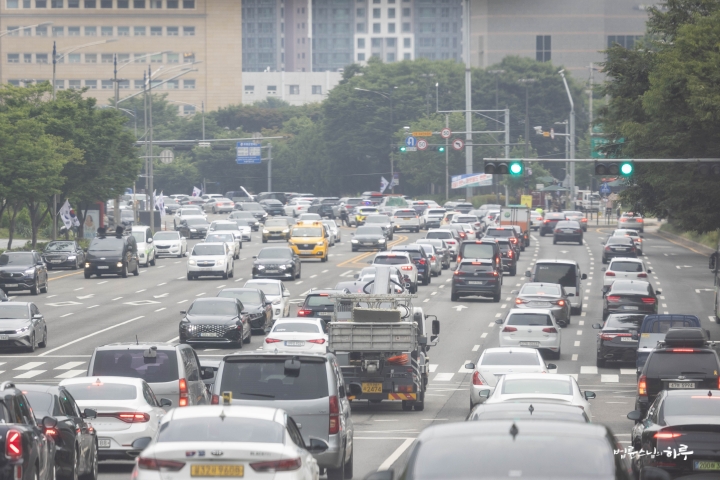
After crossing Banpo Bridge, they quickly arrived at Kyungdong Church located in Jangchung-dong, Jung-gu, Seoul. They headed to the sanctuary following the entrance path to the main building.
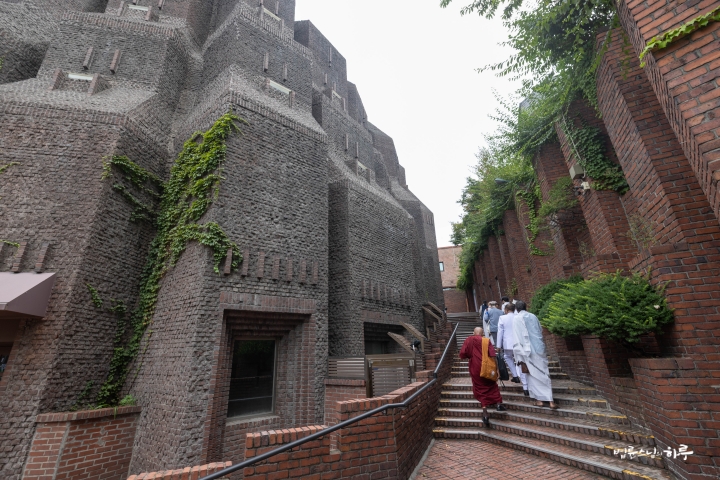
Kyungdong Church is famous for its architecture with theological symbolism and aesthetic originality. The main building symbolizes hands praying for the world, and the entrance path to the main building symbolizes the path to Golgotha toward resurrection.
Reverend Park Jong-hwa, the senior pastor emeritus of Kyungdong Church, opened the church door and warmly welcomed them with a wave.
“Welcome to Kyungdong Church.”

Upon entering the sanctuary, the first thing that caught their eyes was the cross illuminated by sunlight. The Sri Lankan religious leaders quietly approached the cross, feeling its solemnity.
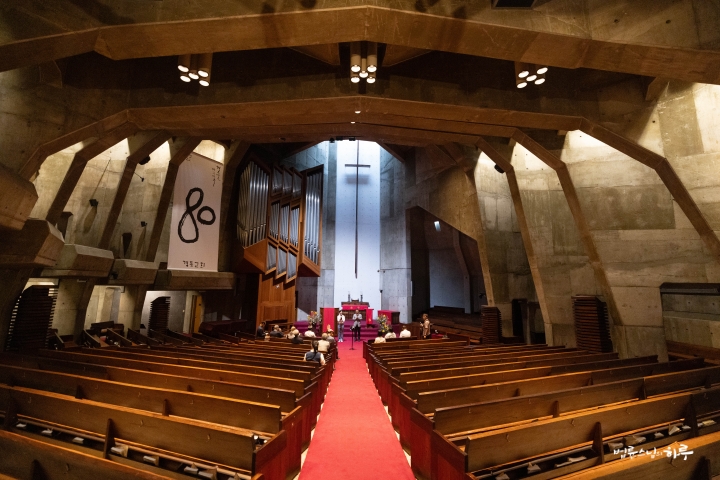
First, Reverend Park Jong-hwa briefly introduced Kyungdong Church.
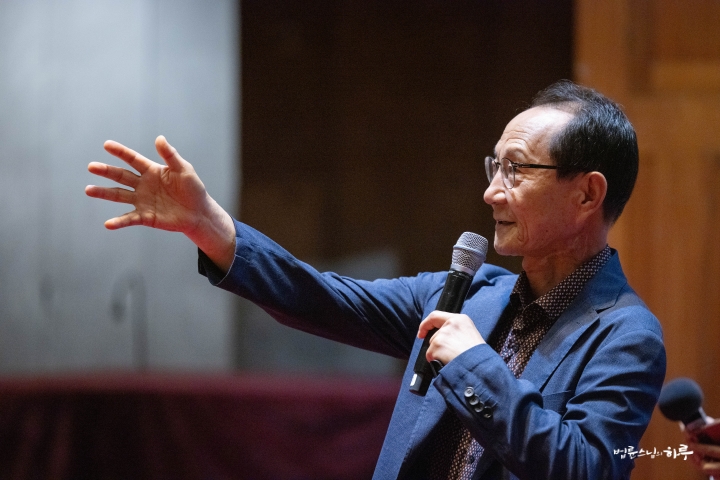
“This church celebrates its 80th anniversary this year. Reverend Kang Won-ryong, the founder of this church, was the first person to initiate interfaith dialogue in Korean society. I came this far after meeting Reverend Kang Won-ryong in my youth. Members of our religious gathering used to gather here every Christmas to hold Christmas services together. At Christmas, Venerable Pomnyun Sunim comes to Kyungdong Church to preach, and on Buddha’s Birthday, I go to Jungto Society to give a Dharma talk.” (Laughter)
Everyone laughed and empathized with the exchange activities between Venerable Pomnyun Sunim and Reverend Park Jong-hwa.
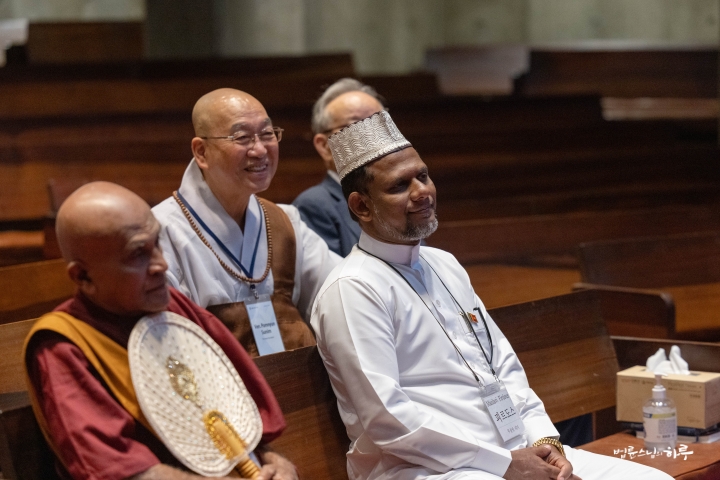
Elder Shin Jung-ki of Kyungdong Church then explained in detail about the history and architectural style of Kyungdong Church.
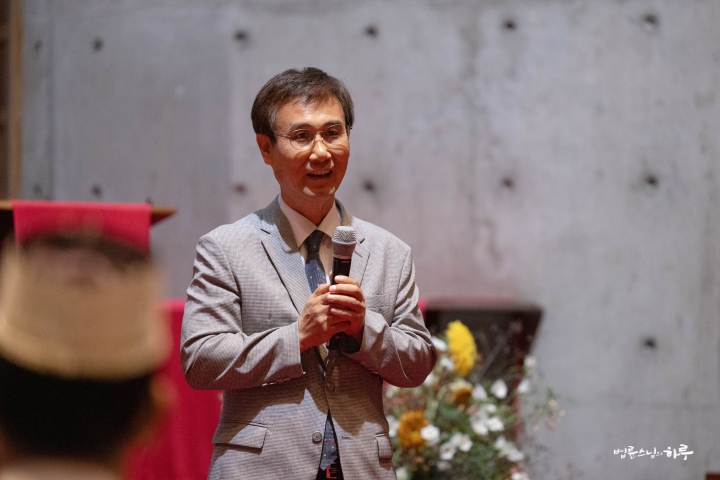
“This is a place where we worship God. The only decorations in this church are the large 17-meter-high cross you see in front of you and the small crosses in the stained glass behind you. The exterior walls of this church are made of numerous cracked bricks. The interior where you are consists only of exposed concrete. The exterior walls represent the suffering of countless people’s lives. The exposed concrete interior has round holes embedded in it, which represent the nail marks of Jesus Christ crucified. The reason for this architecture is to convey the message that we must enter here carrying the world’s suffering, see Jesus Christ crucified, and then go back out into the world. The small crosses in the stained glass mean that we all must carry our own crosses and go out into the world.”
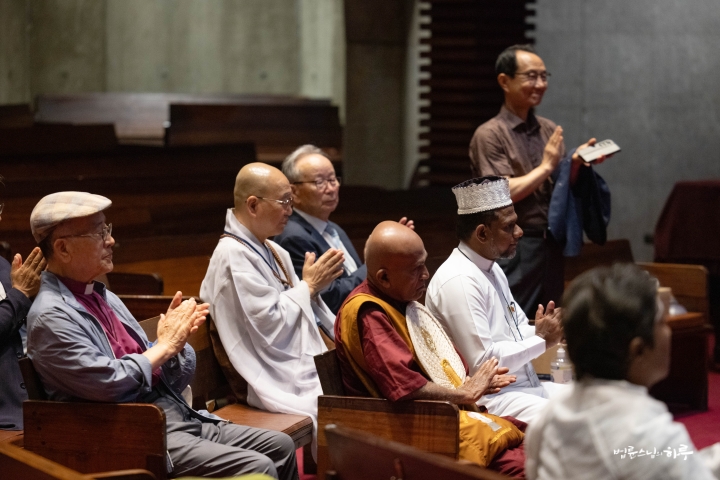
After hearing the detailed explanation, the sanctuary appeared in a new light. They all took a commemorative photo in front of the cross.
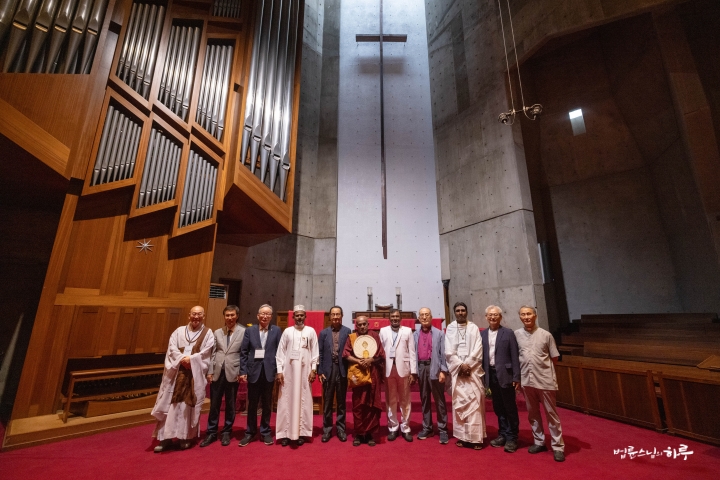
They moved to the mission center for a brief tea conversation.

While having tea, the Sri Lankan religious leaders asked questions about Kyungdong Church. During the conversation, Venerable Pomnyun Sunim also shared about his connection with Kyungdong Church.
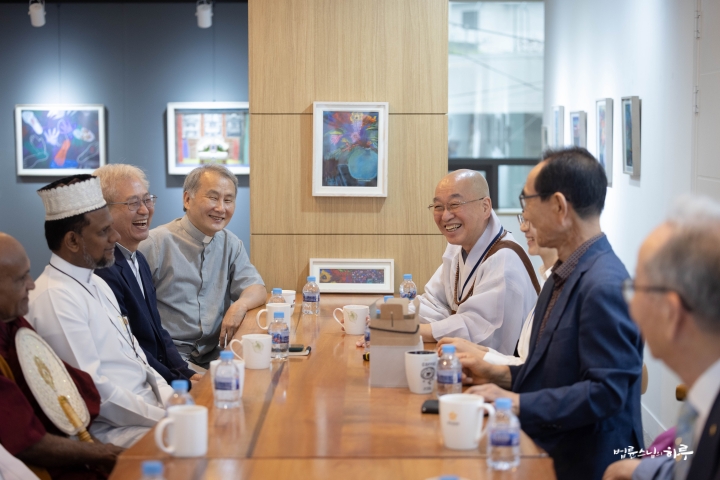
“Kyungdong Church has contributed greatly to Korean society beyond being just a Christian institution. In the 1980s, Korean society experienced great difficulties and conflicts as industrialization progressed rapidly. Rural areas collapsed, farmers flocked to cities increasing urban poverty, and working conditions were very poor. During that time, Kyungdong Church operated the ‘Christian Academy’ to alleviate people’s suffering and ease conflicts in Korean society. Rather than simply spreading Christian doctrine, this place has a history of implementing civic education and responding to social issues.
The Great Legacy Kyungdong Church Left in Korean Society
They facilitated worker education, farmer education, women’s education, dialogue between classes, and interfaith dialogue, and also took the lead in efforts for peace between North and South Korea. When Korean society democratized, many of the key figures at the center were people who had been educated and grown here. In that sense, Kyungdong Church can be said to have made great contributions to the modernization of Korean society beyond being just one church.”
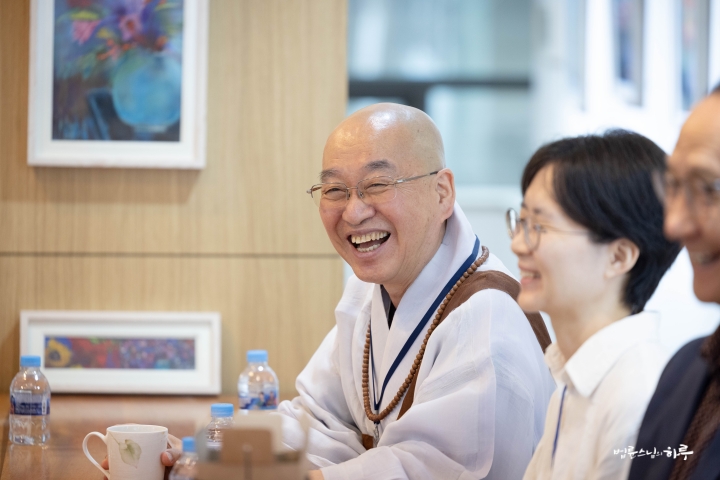
Though they wanted to continue the conversation, they had to hurry as there were many places to visit today.
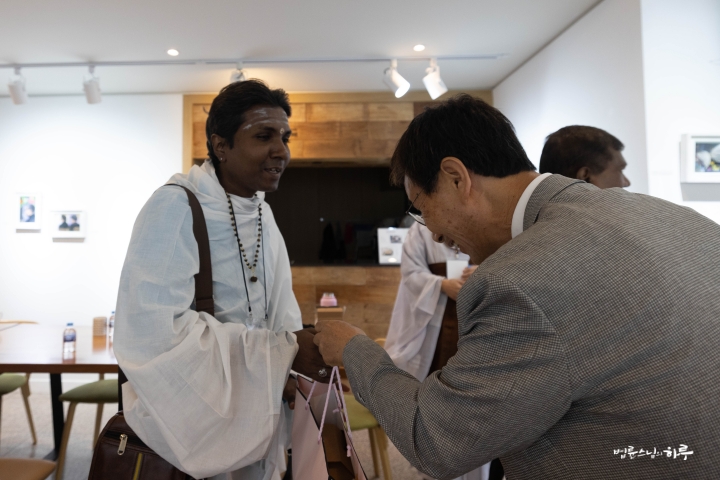
After exchanging farewells, they departed from Kyungdong Church and headed to the Cheondogyo Central Temple.
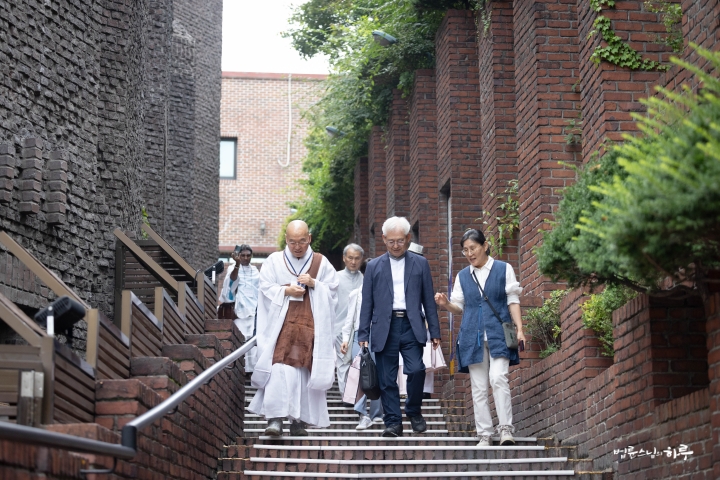
At 9:15 AM, they arrived at the Cheondogyo Central Temple and paid their respects together.
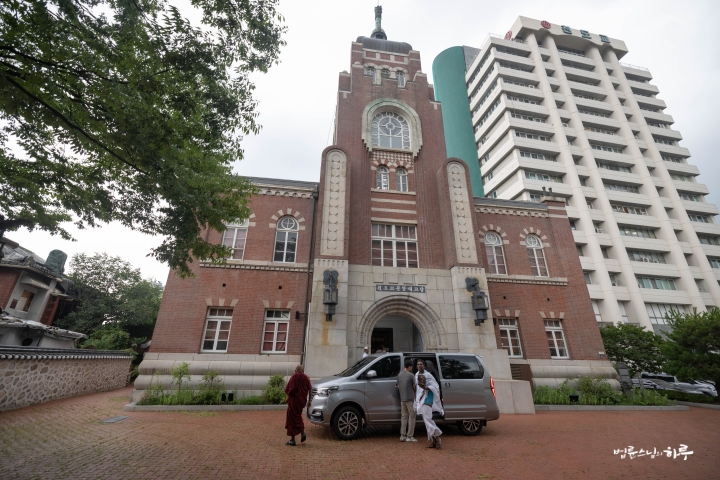
Cheondogyo Director Seo So-yeon warmly welcomed the Sri Lankan religious leaders and then explained in detail about the building’s history.
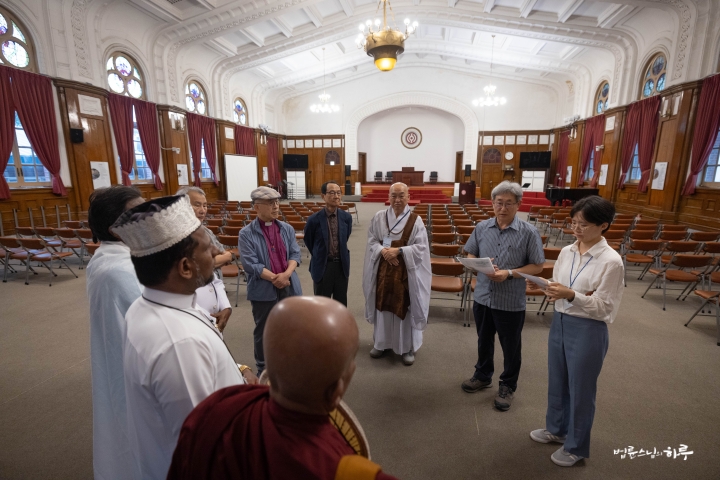
“At the initiative of Son Byeong-hee, the third leader of Cheondogyo, it was decided to build the central temple in 1918, and the ground-breaking ceremony was held in December of that year. Construction couldn’t begin in 1919 because Cheondogyo led the March 1st Independence Movement. Only after the March 1st Movement subsided could construction be completed in 1921. The construction costs were covered by donations from believers, and all remaining funds were used for the March 1st Independence Movement.”
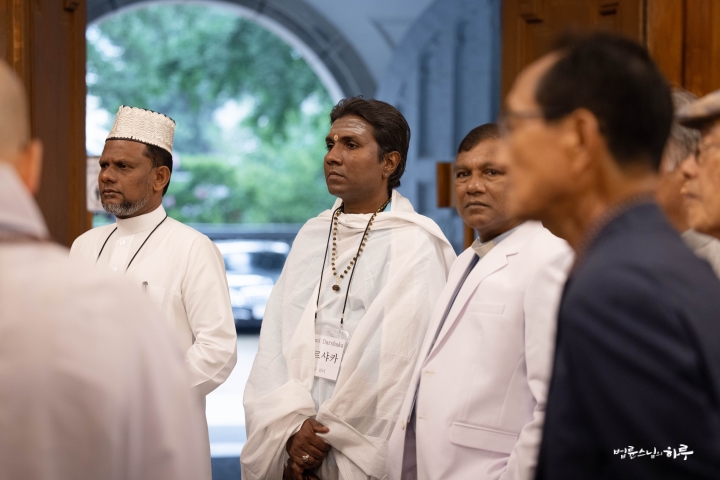
After the director finished her explanation, former leader Park Nam-su added further details.
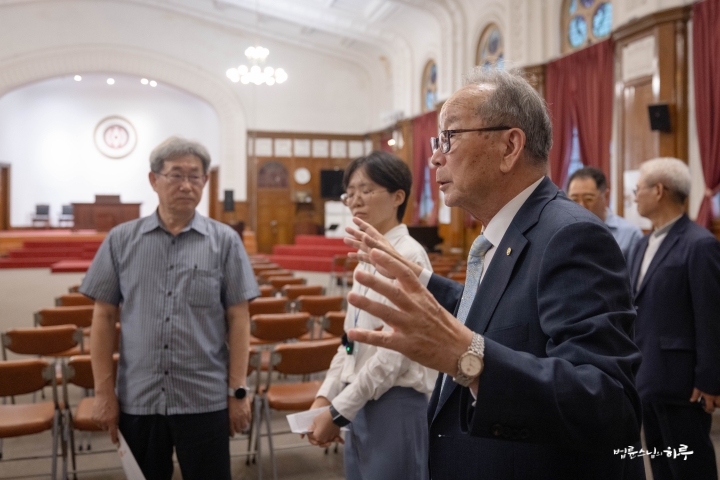
“Many independence activists resided in this area. Korea’s three major religions established themselves in this area and prepared for the independence movement. That’s why the road in front of this building is named March 1st Boulevard. It’s because this is the road where the March 1st Movement was initiated.”
After thoroughly touring this place steeped in independence movement history, they moved to the Cheondogyo Suwoon Hall for tea.
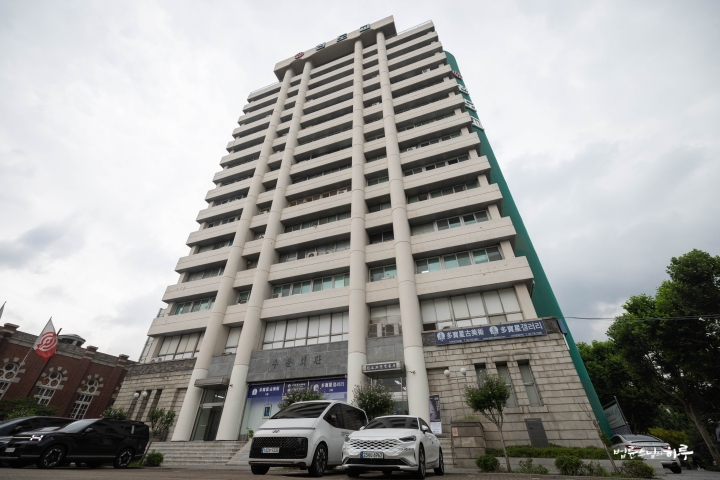
Park In-jun, the current representative of Cheondogyo, warmly welcomed the Sri Lankan religious leaders.
“Thank you for visiting Cheondogyo.”
He then briefly introduced Cheondogyo.
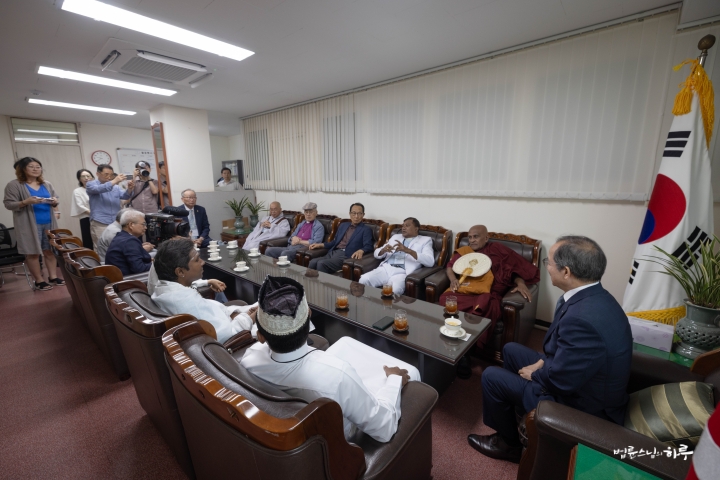
The Pride of Cheondogyo, a Religion That Serves People as Heaven
“Cheondogyo is a religion that serves people as Heaven. We believe that people are Heaven. The core teaching of Cheondogyo is that when dealing with people, we must serve them as we would Heaven. Cheondogyo has made great sacrifices at every critical moment for the Republic of Korea. We take pride in the fact that the spirit that made the Republic of Korea possible came from Cheondogyo. At the time of the March 1st Movement, we were Korea’s number one religion with 3 million followers. Because we used all of Cheondogyo’s funds and manpower for the March 1st Movement, we suffered severe oppression from Japan, and as a result, our influence has weakened. However, scholars studying the roots of the Republic of Korea are showing great interest in researching Cheondogyo, and we are preparing for a new leap forward.”
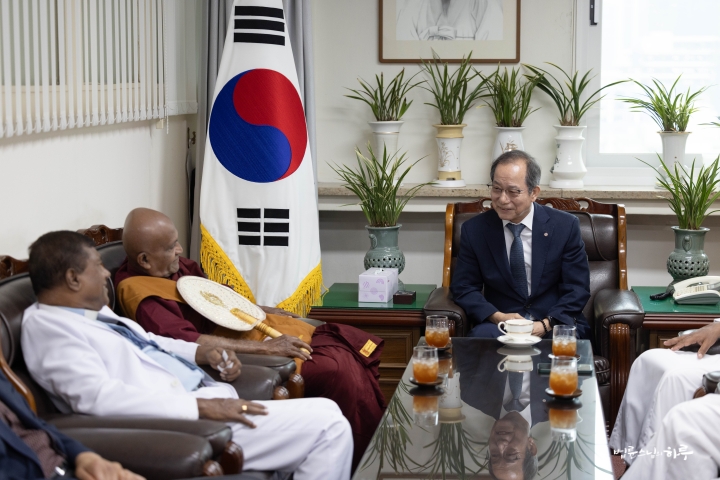
After listening to the explanation, Reverend Anura from Sri Lanka spoke.
“Thank you for the explanation. Sri Lanka had a movement similar to Korea’s March 1st Movement. In Sri Lanka, various religious groups united to resist British colonial rule. While Cheondogyo played a central role as a national religion in Korea, Buddhism played that role in Sri Lanka.” (Laughter)
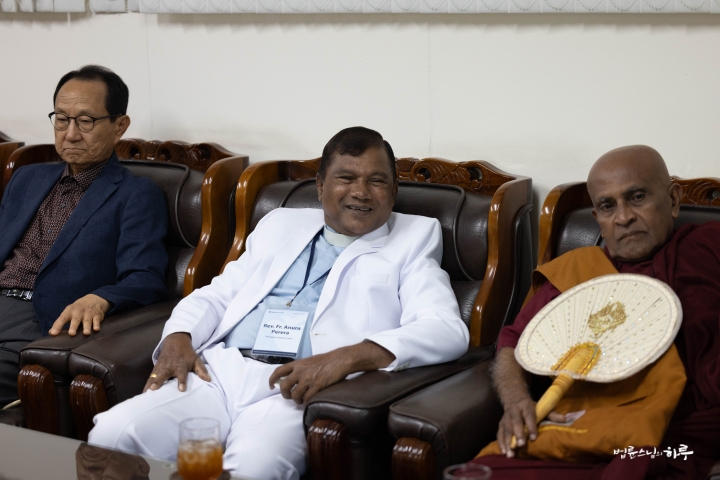
As they conversed, it was time to move to the next location. They left Suwoon Hall, each carrying commemorative gifts from Cheondogyo.
They returned to the Cheondogyo Central Temple and took a group photo together.
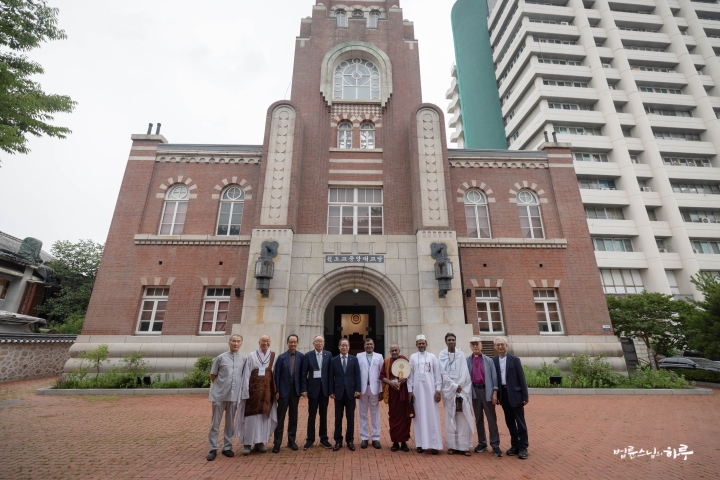
They hurriedly got in the car and headed to Jogyesa Temple in Jongno-gu. After a 10-minute drive, they quickly arrived at Jogyesa.
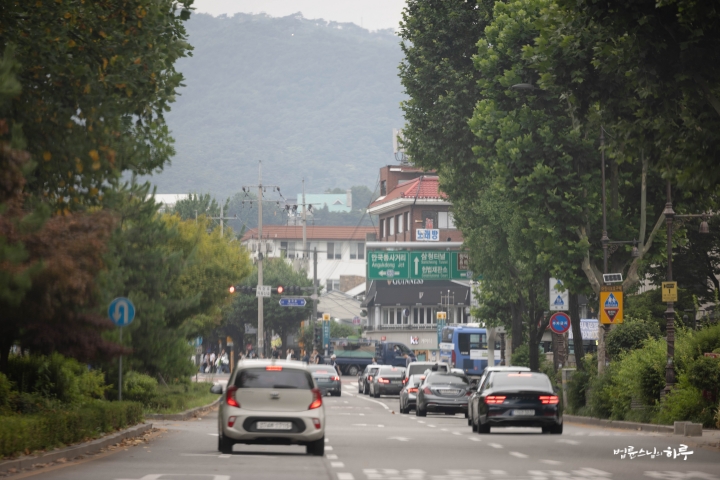
Arriving earlier than scheduled, they toured the Jogyesa grounds together. Chanting sounds resonated loudly from the Main Buddha Hall, and beautiful lotus flowers were displayed in the courtyard.
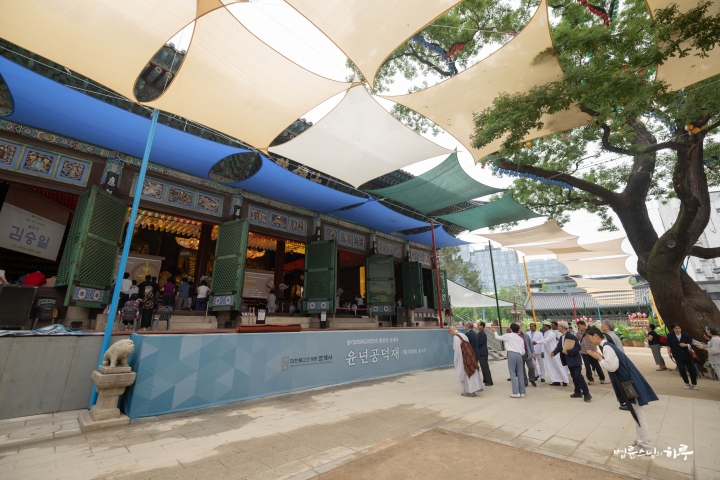
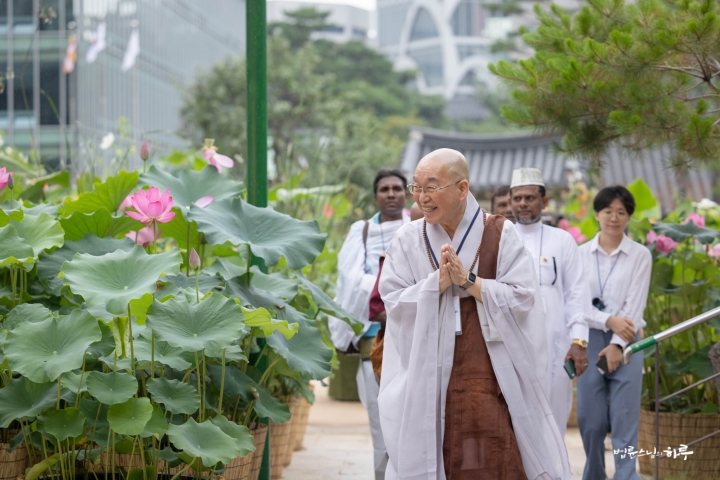
They paid respects at the octagonal 10-story stone pagoda where Buddha’s relics are enshrined and took a group photo in front of the Main Buddha Hall.
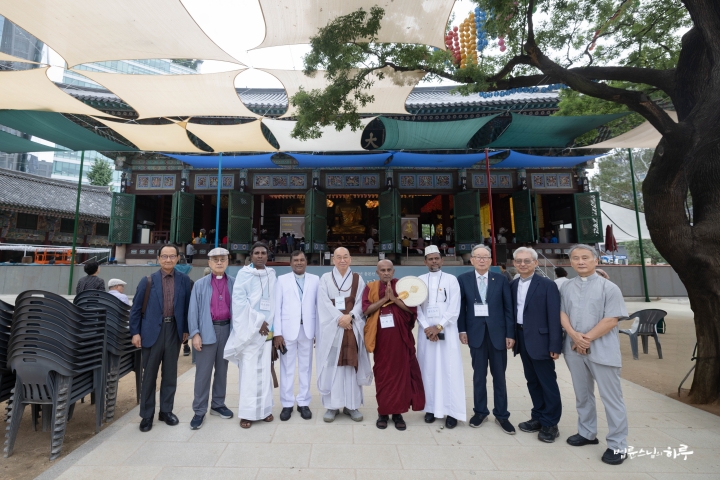
Passing through the lotus flowers decorating the Jogyesa grounds and reaching the One Pillar Gate, Sunim provided an explanation.
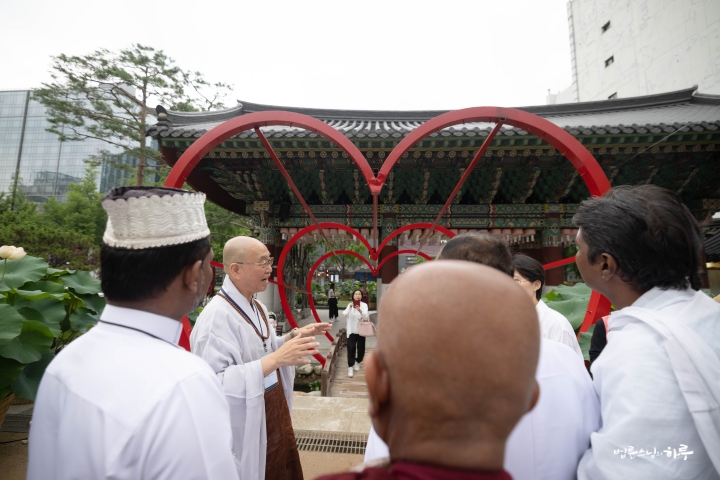
“This is the One Pillar Gate (Iljumun). When entering a temple, the One Pillar Gate is always the first gate you pass through. With the One Pillar Gate as the boundary, this side is Buddha’s realm, and that side is the realm of sentient beings. However, in truth, this side and that side are not two but one. To signify they are not two, it is sometimes written as the Gate of Non-Duality (Bulimun).”
After touring the grounds, it was time for the scheduled visit with the President of the Jogye Order. The Korean Buddhist History and Culture Memorial Hall, where the Jogye Order headquarters is located, had recently suffered a fire and was undergoing restoration work. Therefore, they decided to meet at the temporary office of the President on the 3rd floor of the Jogyesa Temple Stay Promotion Center.
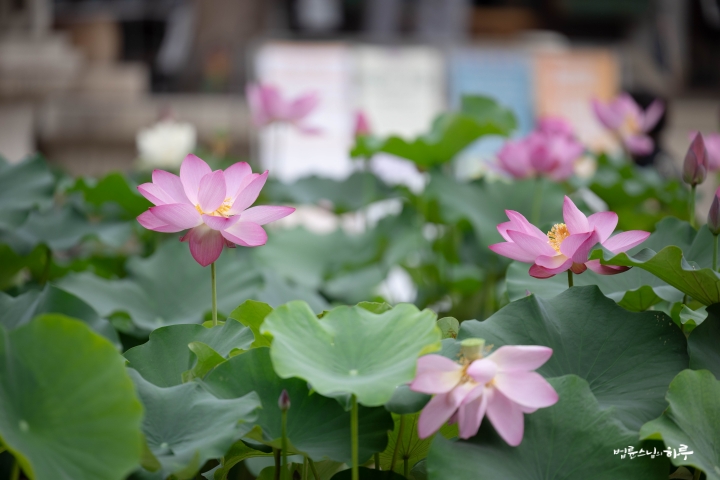
Venerable Jinwoo, President of the Jogye Order, warmly welcomed the Sri Lankan religious leaders.
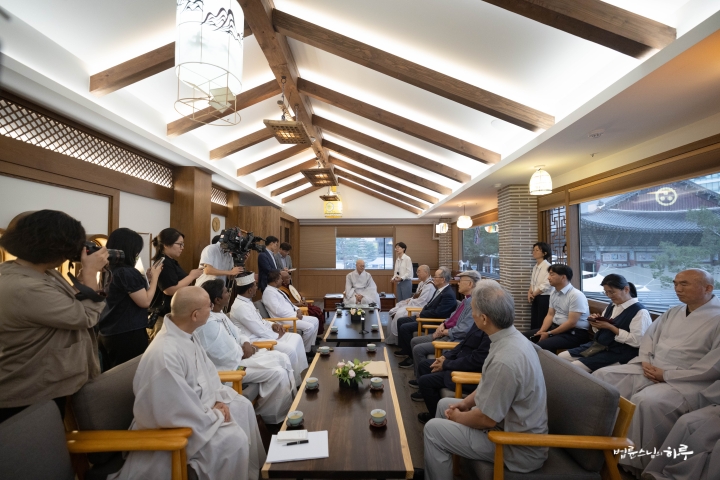
Venerable Jinwoo expressed his gratitude for their efforts toward reconciliation and peace among religious communities.
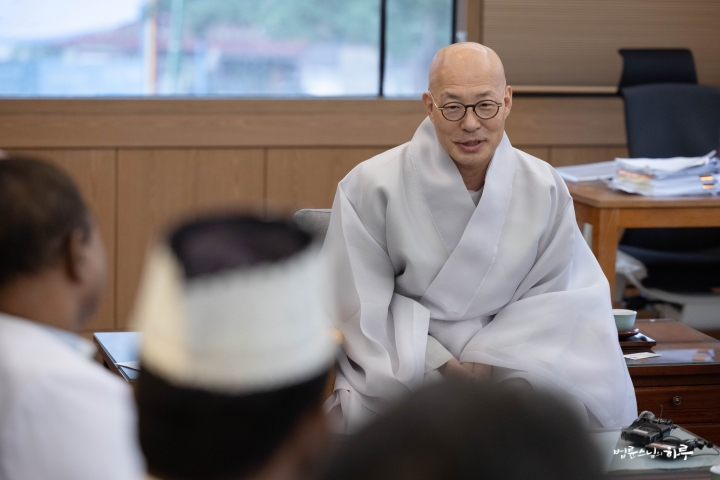
“Historically, inter-religious conflicts have continued, and even now, conflicts are occurring in some areas. The purpose of religion is to help people live happily. If disputes arise between religions due to conflicting interests, that deviates from the original purpose of religion. Therefore, I believe religious people should set an example. In that sense, I am reassured to hear that such religious gatherings are actively operating in Sri Lanka and Korea. Moreover, I consider it an honor that you have visited our Jogye Order.”
Venerable Asaji from Sri Lanka conveyed gratitude on behalf of the religious leaders and introduced the activities of Dharma Shakti.
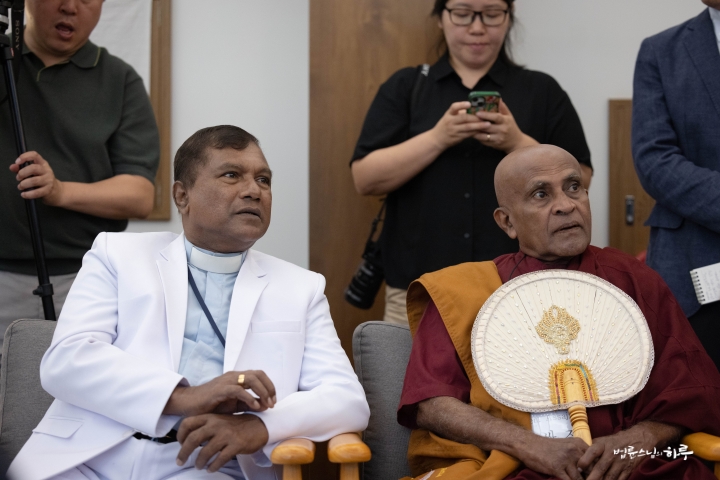
“Thank you for welcoming us at the Jogye Order, which represents Korean Mahayana Buddhism. In Sri Lanka, 70 percent of the population are Buddhists who follow Theravada Buddhism. Four religions in Sri Lanka have come together to form an organization called Dharma Shakti. When natural disasters such as tsunamis occur, we work together to help each other. We treat all ethnicities and religions equally to achieve reconciliation and peace.”
Venerable Jinwoo asked with a smile.
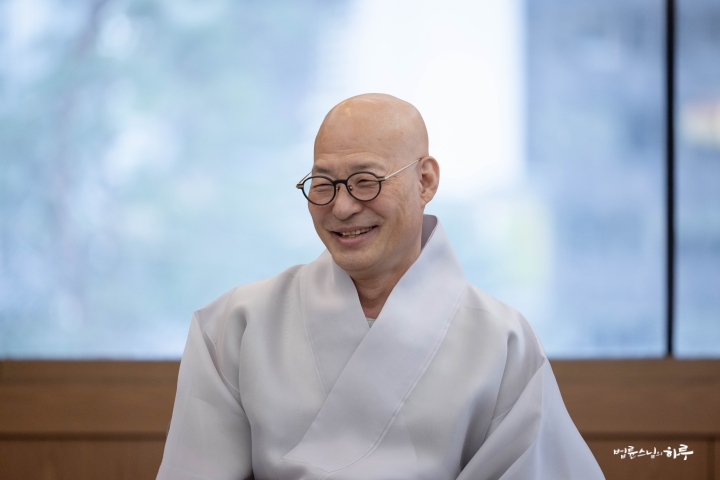
“In Korea, various religions are not particularly close but seem to get along well. In Sri Lanka, do the four religions get along well without conflict?”
Pastor Anura replied with a smile.
“Yes, of course. We get along well.”
Sunim added a comment.
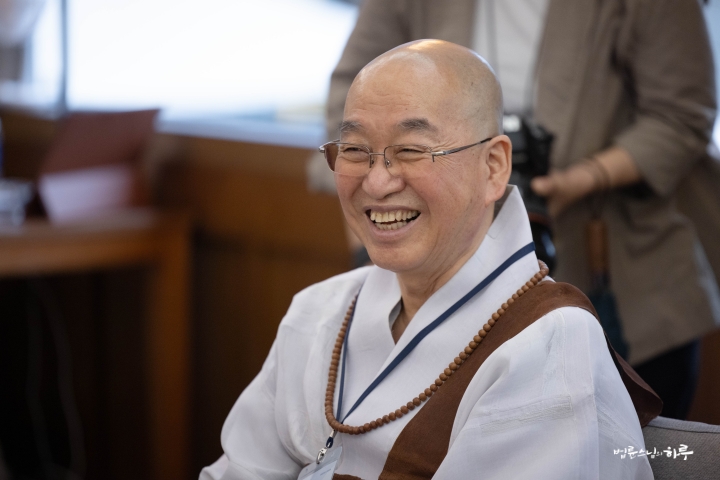
“This Sri Lanka experienced a 30-year civil war due to ethnic conflicts. In such circumstances, it must not have been easy for four religions to live in harmony.”
Venerable Jinwoo showed great interest in the religious gathering for ethnic reconciliation and peace.
“What activities does the religious gathering mainly engage in?”
Sunim replied.
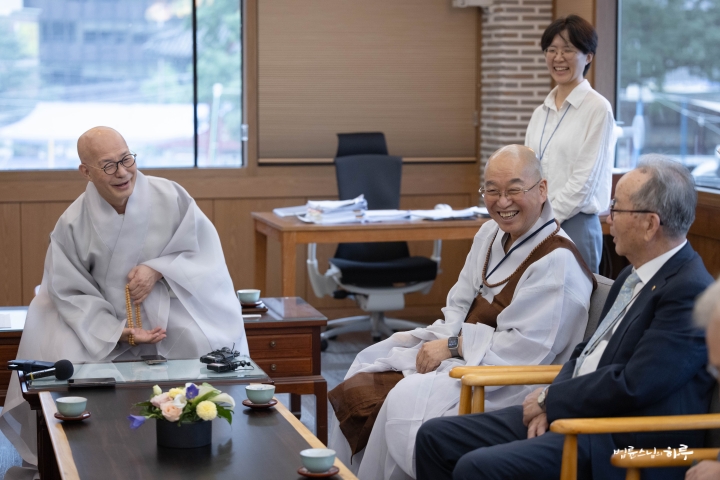
“Our religious gathering engages in three main activities. First, we work to improve inter-Korean relations for peace on the Korean Peninsula. Second, we provide humanitarian aid to North Korean residents. Third, we work to achieve national integration within South Korea. We started by working together on the movement to help North Korean compatriots, and we have been meeting monthly for 27 years now.”
After finishing the conversation and taking a commemorative photo, they hurriedly left Jogyesa Temple.
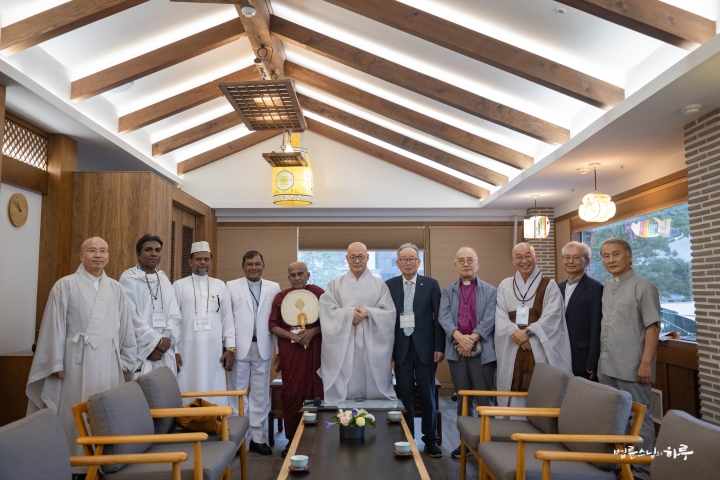
Next, they headed to the Anglican Church of Korea Seoul Cathedral. When the Sri Lankan religious leaders arrived at the cathedral, former Bishop Park Kyung-jo warmly welcomed them.
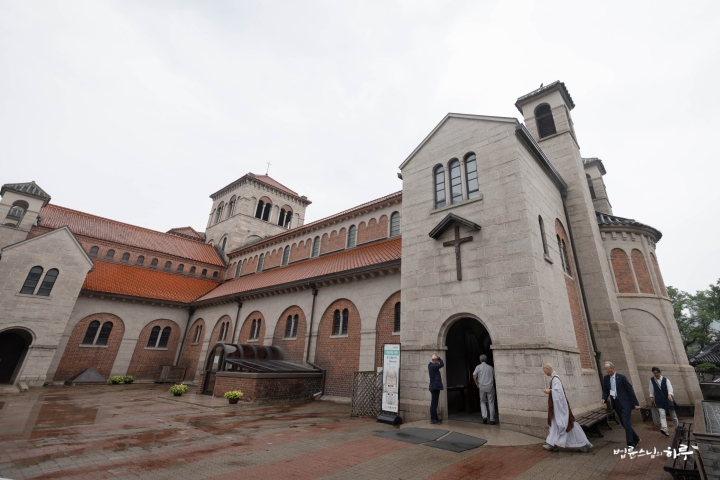
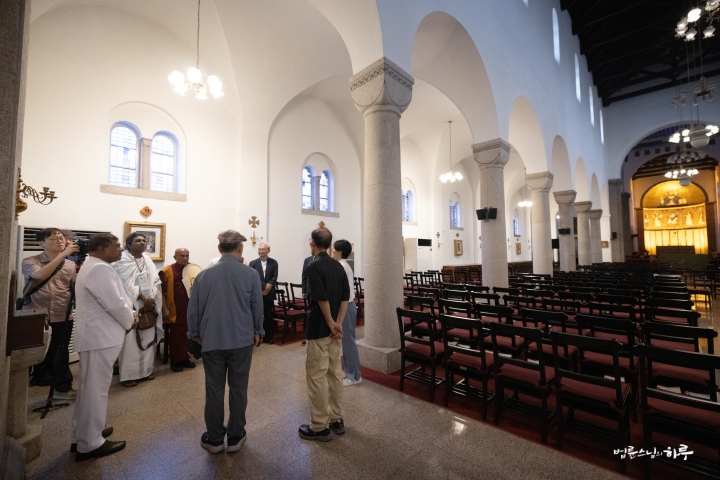
“Thank you for visiting the Anglican Church of Korea. I served as bishop here for five years. Today, our church’s honorary clergy member will provide the tour directly in English.”
He provided detailed explanations of various parts of the cathedral.
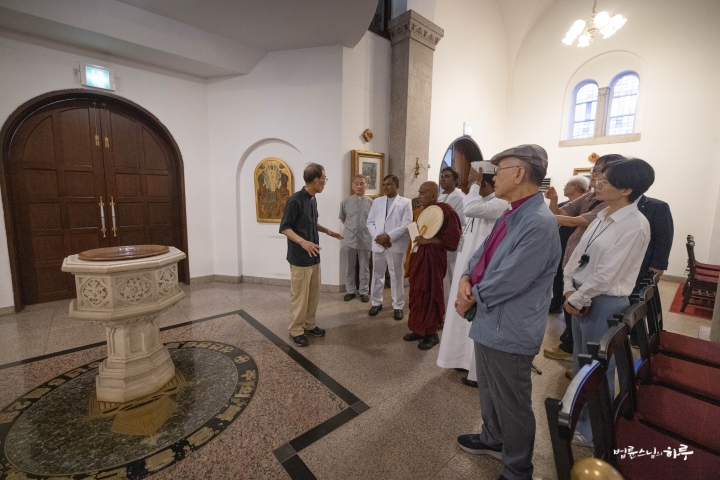
“The history of this place began in 1890 when the bishop and believers sent from England for Anglican missionary work in Joseon purchased the hanok (traditional Korean house) where the cathedral now stands. The second bishop who took office in 1910 planned to build this new cathedral, and his successor, the third bishop, invited a British architect to design this cathedral. We used this cathedral for almost 70 years after its first completion in 1926. However, the first completion was not fully finished according to the original design. So, 70 years after the first completion, in 1992, this cathedral was expanded according to the original design.”
They then moved to the chapel where the explanation continued.
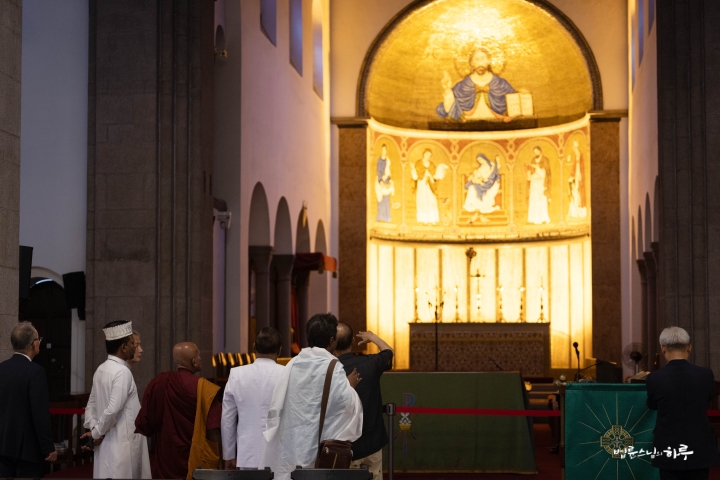
“As you can see, Jesus Christ is blessing us while holding the Bible. The book has Latin text that reads ‘Ego sum lux mundi,’ which means ‘I am the light of the world.’ Below is the Virgin Mary holding baby Jesus, on the right is the prophet Isaiah, and on the left is John the Evangelist. On the far left is St. Stephen, the first martyr, and on the far right is Bishop St. Nicholas with children.”
After touring the chapel, they took a commemorative photo together.
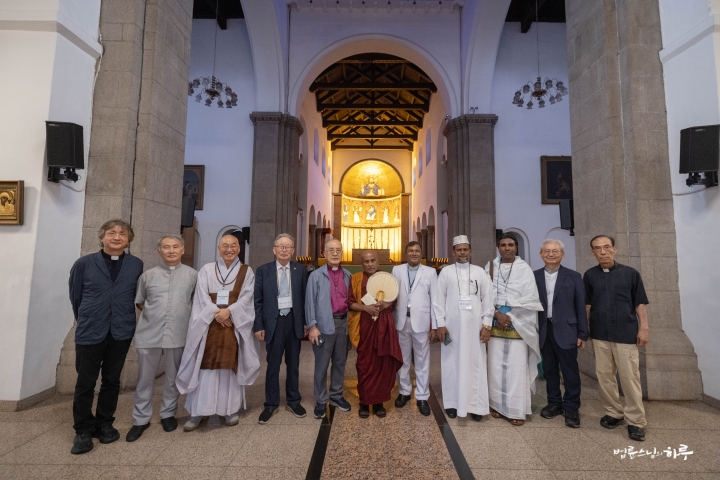
After visiting the space commemorating martyrs, they left the cathedral.
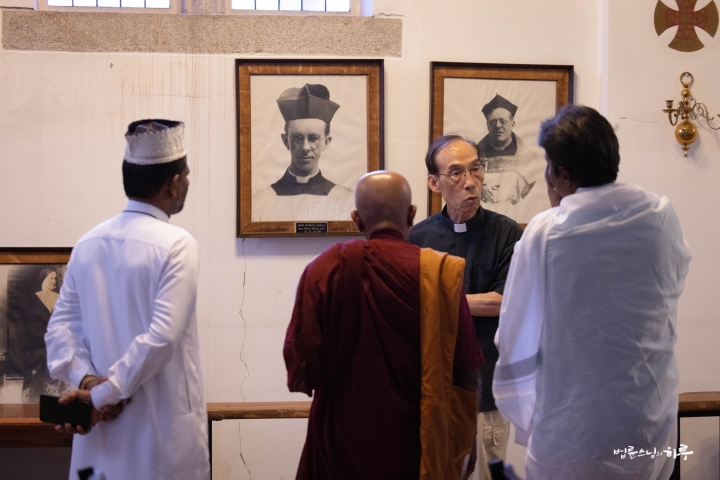
They headed to the hanok building currently used as the bishop’s office.
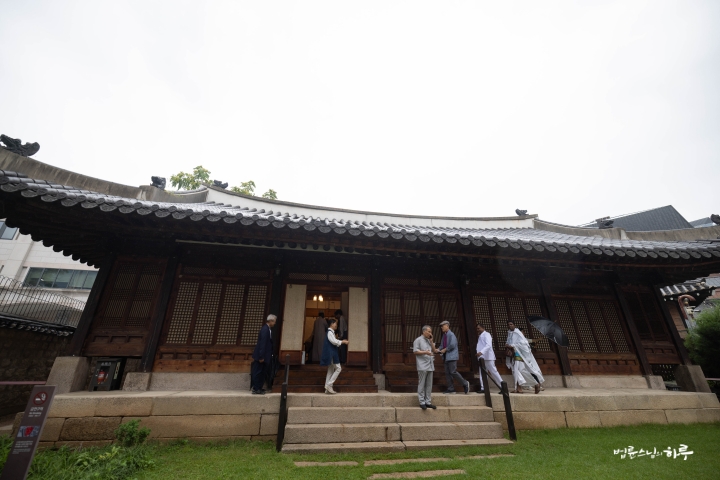
Inside the hanok building, photographs of successive Anglican bishops were displayed. Bishop Park Kyung-jo served as the fourth diocesan bishop as a Korean. Bishop Park introduced the current diocesan bishop, Bishop Kim Jang-hwan.
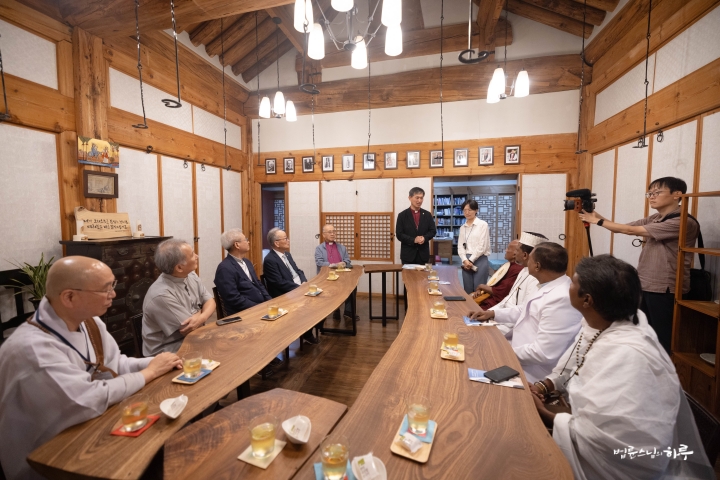
“This person actively participated in the democratization movement in his youth and has lived a very passionate life. He is currently serving as the seventh diocesan bishop of the Anglican Church of Korea.”
Bishop Kim Jang-hwan then welcomed the Sri Lankan religious leaders.
“Welcome to our Anglican Church of Korea Seoul Cathedral.”

The bishop then briefly introduced the Anglican Church of Korea.
The Anglican Church of Korea’s Journey for the Poor and Democratization
“The Anglican Church of Korea has been with Korea throughout its modern and contemporary history. When Korean society achieved economic growth through industrialization, we focused for a long time on missionary work for the poor people in the shadows. We have a proud history of establishing a missionary organization called the House of Sharing, living with them in poor areas, and dedicating ourselves to improving human rights and quality of life. Also, when Korean society was groaning under dictatorial power, the June 10 Democratic Uprising movement occurred, and this Anglican Cathedral was its epicenter. We have also been working for reconciliation and peace between the divided North and South.”
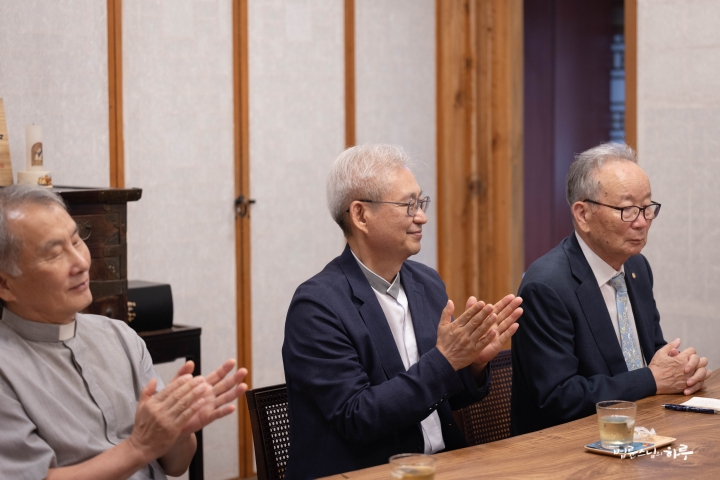
When the bishop finished his explanation, Sunim added a comment.
“Among Korea’s various religions, it can be said to be the most progressive. It has Sungkonghoe University under its umbrella, which has produced many progressive scholars in Korea.”
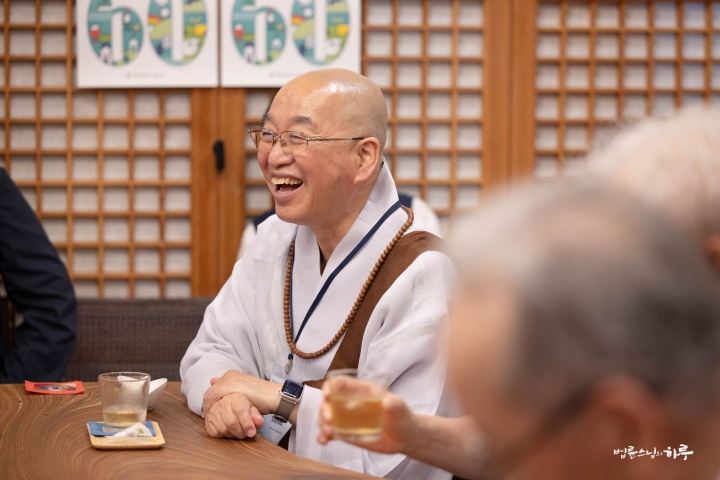
Pastor Anura from Sri Lanka introduced that there is also an Anglican Church in Sri Lanka and shared their experience of how they resolved ethnic conflict elements that were inherent within the church.
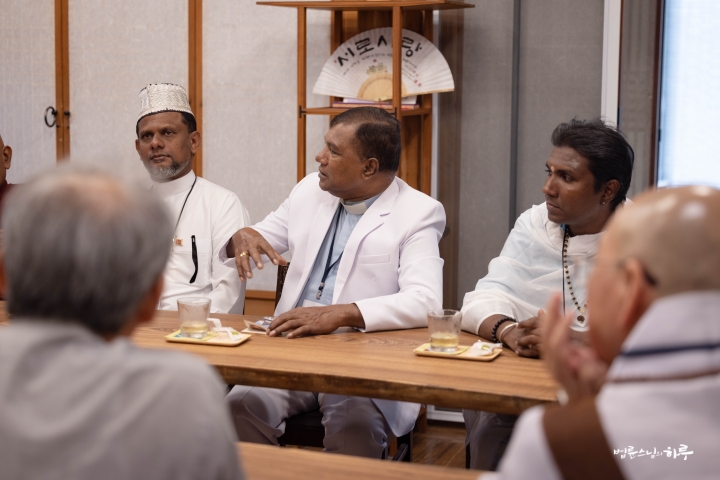
“Sri Lanka also has Methodist and Anglican churches, but churches were divided by ethnicity, which became a source of conflict. For example, there were Tamil Anglican and Sinhala Anglican churches, and Tamil Methodist and Sinhala Anglican churches, separated in this way, causing conflicts. The solution we came up with was to have bishops alternate between the two ethnic groups every five years. This method greatly helped in resolving conflicts.”
The bishop smiled and empathized.
“That was really a wise solution.”
Finally, the bishop distributed commemorative gifts to the Sri Lankan religious leaders.
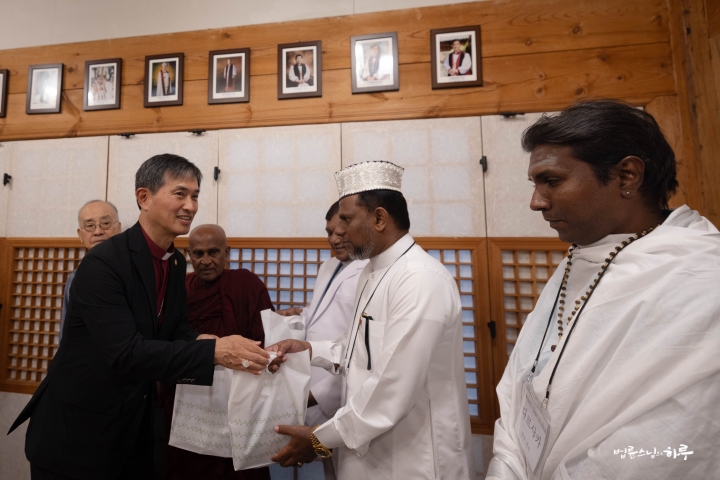
With this, they completed the tour of each religious organization to which the members of the religious gathering belong. Sunim announced the next schedule.
“The next schedule is to enter the Military Demarcation Line that divides North and South Korea. If we have lunch here before departing, we’ll be late, so we’ll eat lunch boxes in the car while traveling. Is that okay?”
“No problem!”
After taking a group photo outside, they departed from the Anglican Cathedral of Seoul and headed to the DMZ (Korean Demilitarized Zone), the site of the division between North and South. As heavy rain poured down, barbed wire fences could be seen through the car windows, indicating they were approaching the ceasefire line.
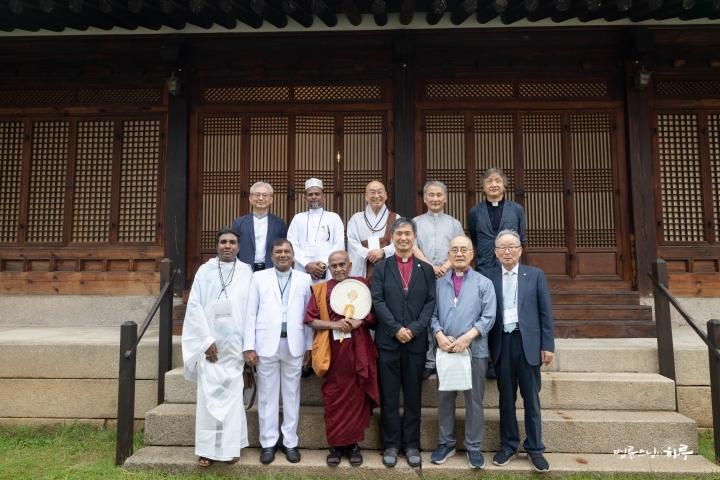
While sharing kimbap and sandwiches and conversing in the car, they arrived at Paju Unification Bridge at 1:30 PM. From here, it’s a civilian control zone, so they had to pass through a checkpoint.
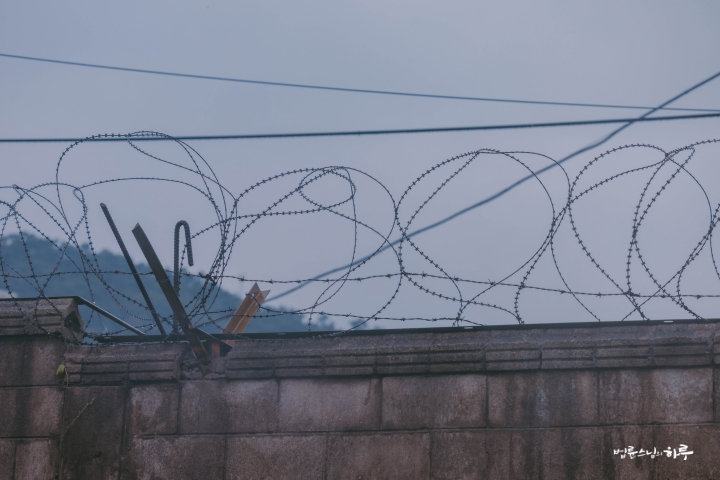
After passing through the checkpoint with multiple barricades, they followed the mountain road up until Dorasan Observatory appeared.
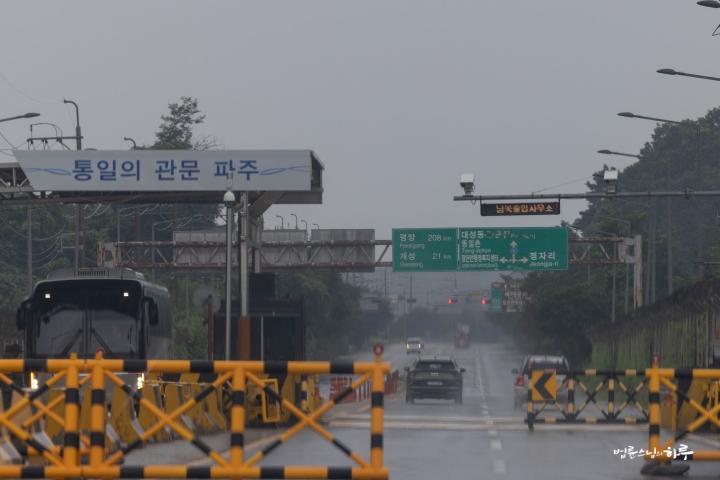
Upon entering Dorasan Observatory, a guide warmly greeted them and provided detailed explanations. Unfortunately, due to heavy rain and thick fog, North Korean territory was barely visible.
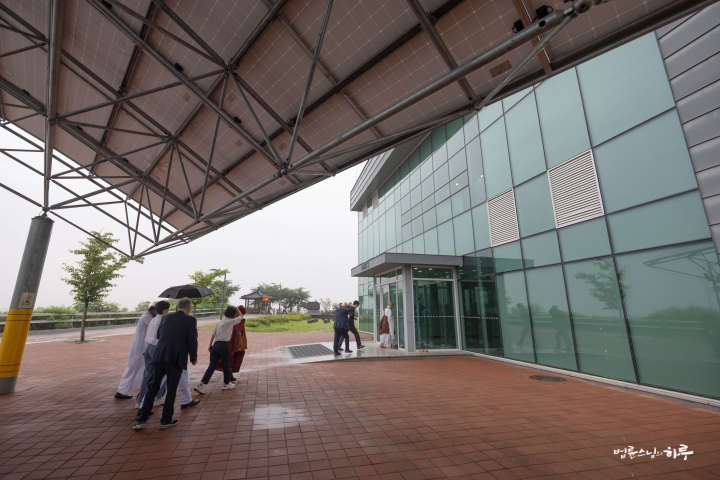
However, the guide pointed to a model of the demilitarized zone and explained in detail. With comprehensive explanations about the characteristics of the DMZ, the Sacheon River and military demarcation line, North Korean outposts and infiltration tunnels, Kaesong Industrial Complex, Daeseong-dong village, Panmunjom (JSA), and the historical significance of the Sacheon River battle, the Sri Lankan religious leaders could understand as clearly as if they had seen the landscape directly on a clear day.
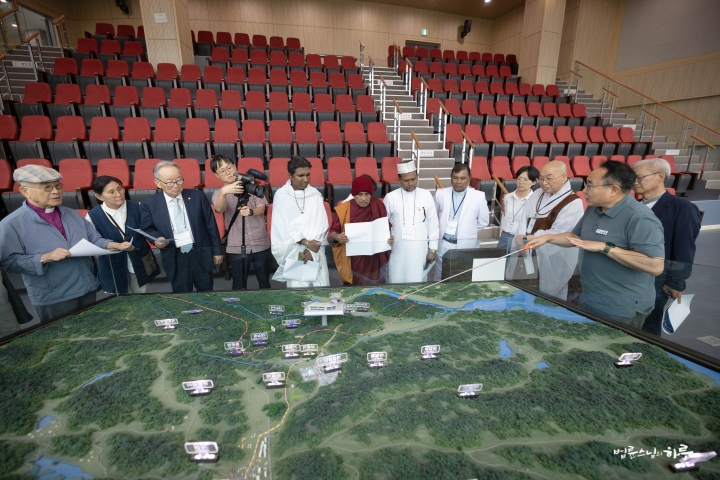
“You can see the North Korean mountains over there, and underground bunkers are hidden in those mountains. Military supplies and long-range artillery capable of reaching Suwon City south of Seoul are deployed there. Kaesong City is located here, and south of Kaesong City is the Kaesong Industrial Complex. The Kaesong Industrial Complex was a symbol of inter-Korean economic cooperation, but operations have been completely suspended due to heightened military and political tensions.
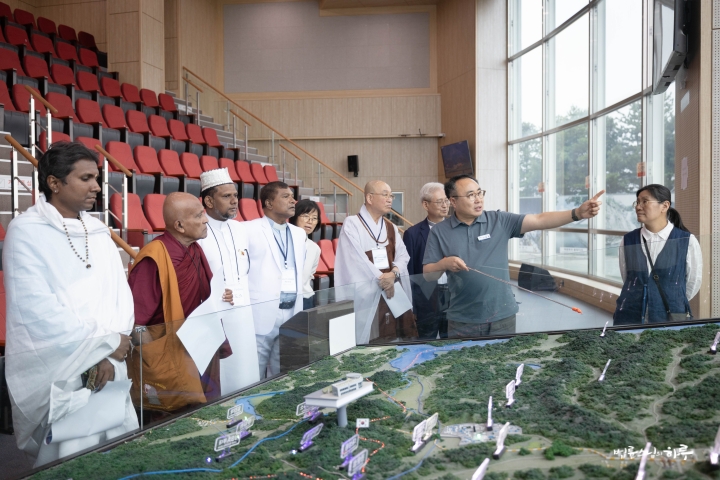
Do you see the river down there? What you see at 12 o’clock is the Sacheon River, which serves as a natural boundary. You can think of the military demarcation line as passing right in front of it. The small concrete structure on the hill to the left of the river is a North Korean outpost.”
The Sri Lankan religious leaders deeply empathized with the tragedy of war as they listened to the guide’s explanation of how devastating the war had been. This was because Sri Lanka had also experienced a long civil war and lost countless lives.
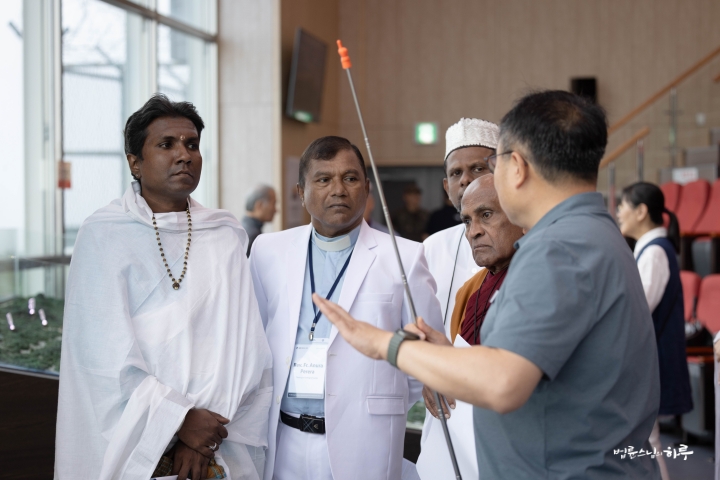
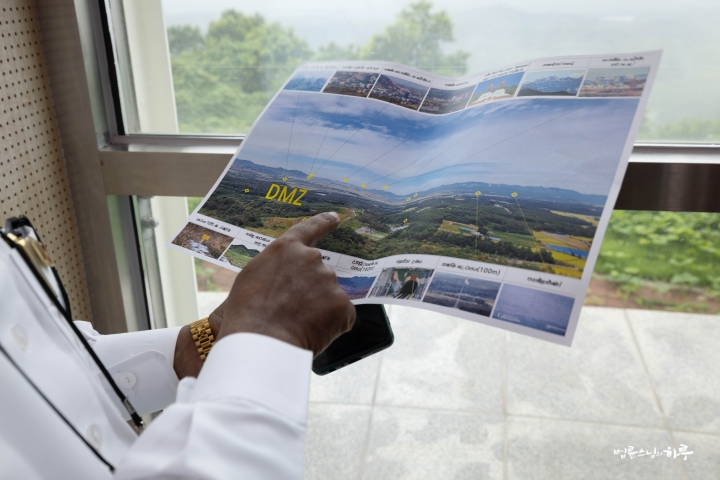
Although they couldn’t directly see North Korean territory due to the fog, they could vividly see North Korea through video footage on the monitors.
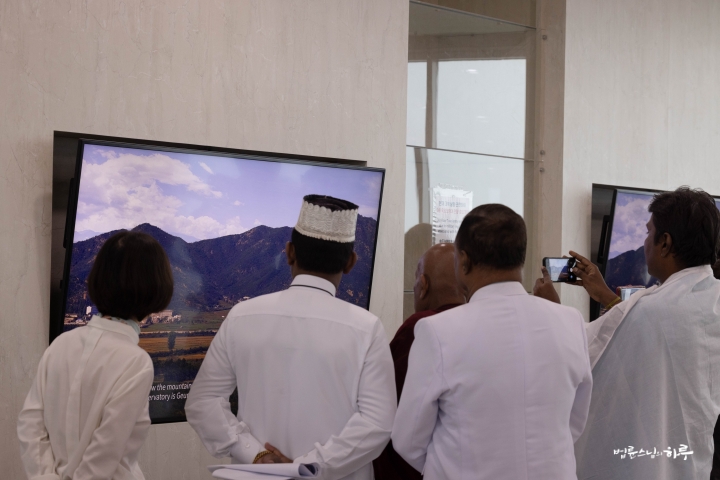
The screen clearly showed the empty buildings of Kijong-dong, the idle factories of the Kaesong Industrial Complex, and North Korean outposts. These videos, filmed on clear days, showed another world just a few kilometers away. The sight of the Kaesong Industrial Complex, once a symbol of inter-Korean economic cooperation, standing empty, and the Kijong-dong apartment complex where North Korean workers once lived now abandoned, made the reality of division feel even more vivid.
After expressing gratitude to the guide for the kind explanation, they took a group photo together and left Dorasan Observatory.
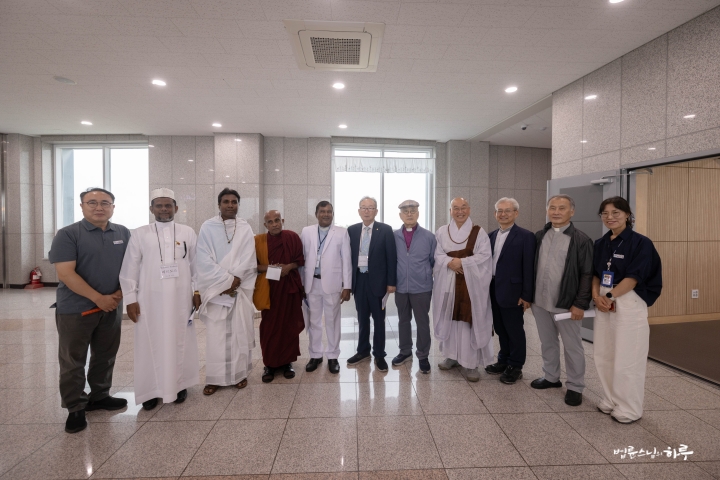
They departed from Dorasan Observatory at 2:40 PM and headed back to the Jungto Social and Cultural Center in Seoul.
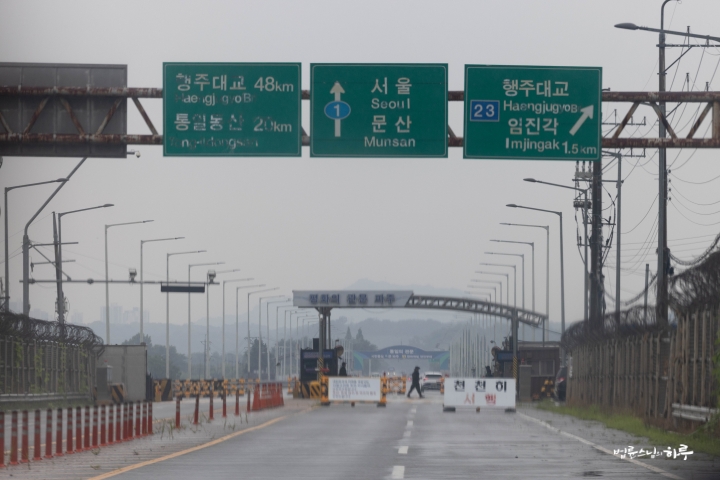
On the way back, the Sri Lankan religious leaders visited an Islamic mosque in Itaewon. Firdous, the Muslim leader from Sri Lanka, was very pleased to see an Islamic mosque in Korea.
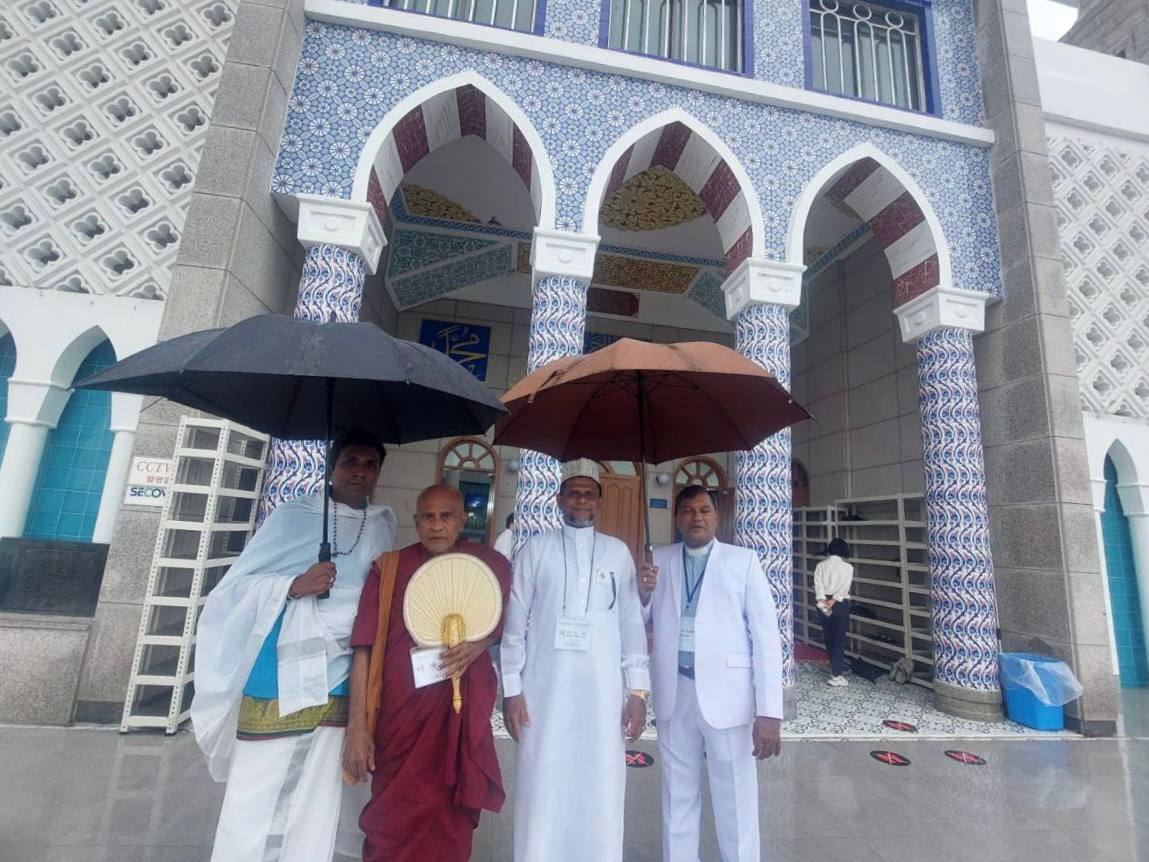
After a brief prayer, they left the mosque and moved to the Jungto Social and Cultural Center.
Sunim, the Bishop, the former Head Priest, the Catholic priest, and the Won Buddhist priest arrived at the Peace Foundation conference room at 4 PM and immediately held an interfaith gathering. Originally, the interfaith gathering was scheduled for next week, but they decided to move it up a week to today to also serve as an evaluation meeting for this event.
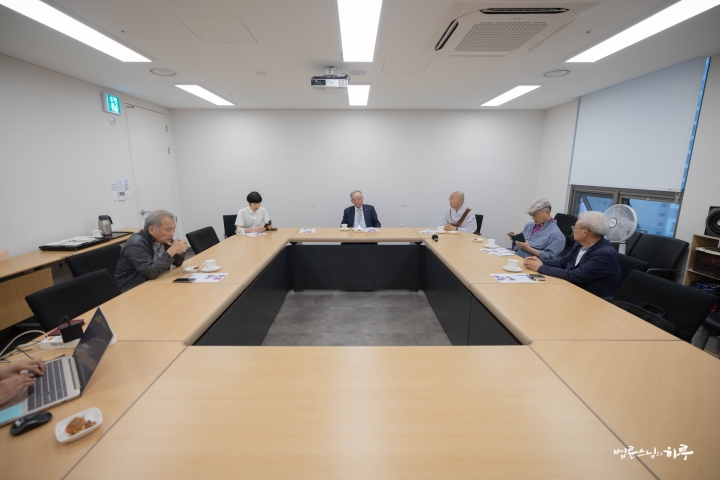
First, the Peace Foundation presented their plan to hold a commemoration ceremony and forum for the 80th anniversary of Liberation on August 14th and gathered opinions from the religious leaders.
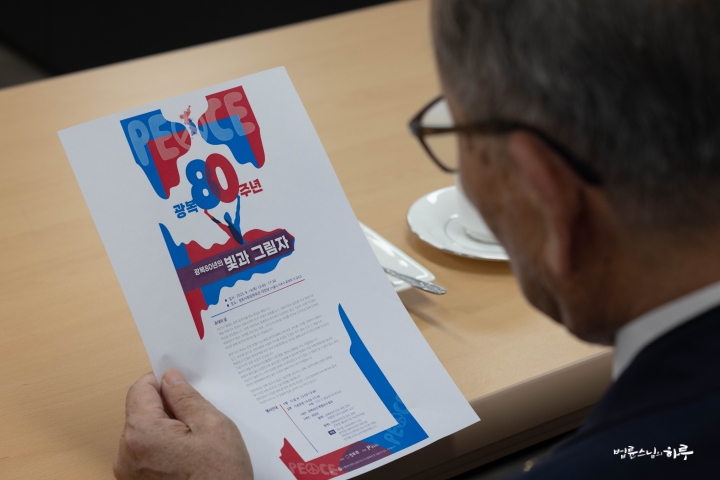
Everyone expressed that a commemoration ceremony alone might not be sufficient to capture the great significance of the 80th anniversary of Liberation, and discussed the need for more proactive actions to pray for war prevention and national unity. After listening to the religious leaders’ opinions, Sunim also shared his thoughts.
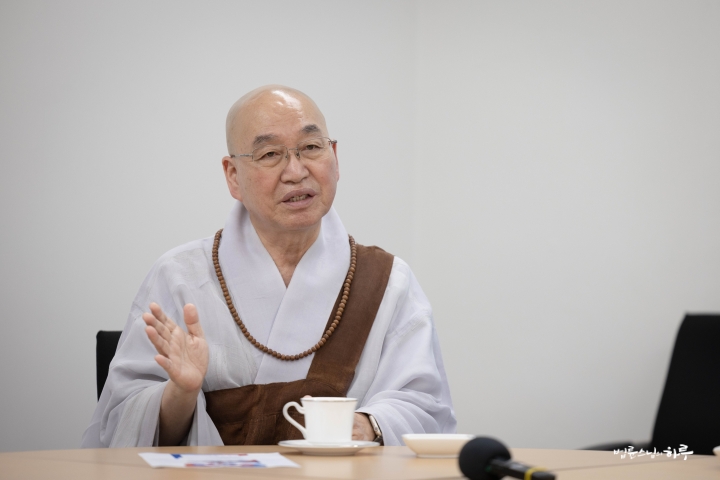
“To promote action for peace on the Korean Peninsula on the occasion of the 80th anniversary of Liberation and to draw out a national appeal in time for Liberation Day, we should have started preparing from spring. However, due to the presidential impeachment and early elections, we couldn’t prepare properly. So it will be difficult to align with Liberation Day this year, and we’ll try to pursue it at the end of the year or next spring.
Dreaming of Religious Solidarity for Peace on the Korean Peninsula and Asia on the 80th Anniversary of Liberation
Listening to the vivid experiences of ‘Dharmashakthi,’ an interfaith solidarity organization active in Sri Lanka, we learned that they carried out practical activities for peace even in much more difficult circumstances than ours. Compared to those who took action even during civil war, we are in much better conditions. So I hope we don’t end this 80th anniversary of Liberation commemoration as a one-time event, but continue it as a long-term project.
This time, we invited the Sri Lankan Dharmashakthi gathering to Korea and took the first step in international interfaith solidarity. Going forward, we plan to evaluate this activity well and expand exchanges with other Asian countries. Originally, we wanted to invite religious leaders from various countries together. For example, Cambodia has experience achieving peace by giving rebel forces governor positions in occupied territories. Sri Lanka achieved reconciliation only after completely defeating the rebels. Since each country has different situations and solutions, it would have been difficult to introduce them all within the limited time of an hour and a half. I hope we can continue to hold such international events and gather cases from Indonesia, Cambodia, Sri Lanka, and other countries. I think we can create a platform for religious exchanges for peace not just on the Korean Peninsula but throughout Asia. As former Head Priest Park Nam-soo, the chair of our interfaith gathering, mentioned, let’s not end this as a one-time event but continue it steadily.”

Subsequently, the Sri Lankan religious leaders arrived at the Peace Foundation. Sunim suggested having a time to share reflections with each other.
“Now let’s briefly share our reflections and wrap up.”
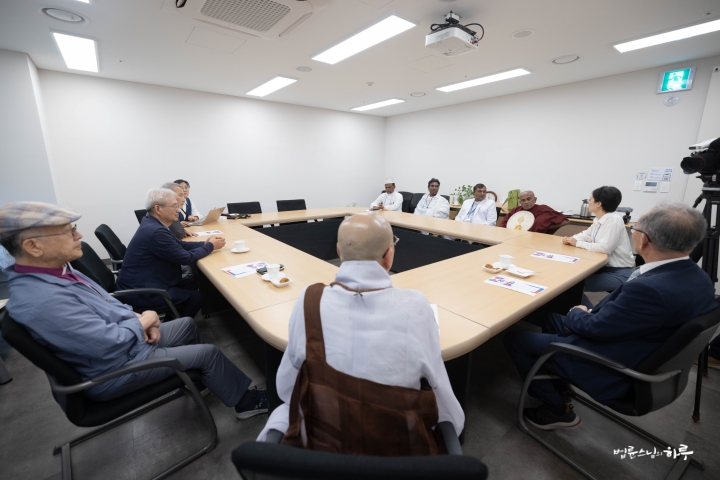
Everyone sat together in a circle and shared their thoughts and feelings from the past three days together. First, Father Kim Hong-jin shared his reflections.
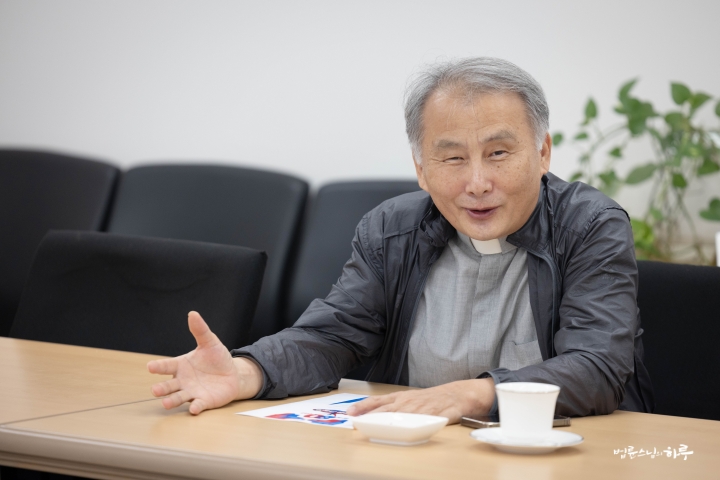
“I express my deep respect and admiration for Dharmashakthi’s 30-year journey. The activities that Dharmashakthi has consistently carried out have been a great inspiration to me. Among the ten principles you mentioned, I was particularly impressed by the use of the first person singular ‘I’ rather than the plural expression ‘We.’ I pray that your journey will continue to bear even more beautiful fruits in the future.”
Next, Gyomu Kim Dae-seon shared his reflections.
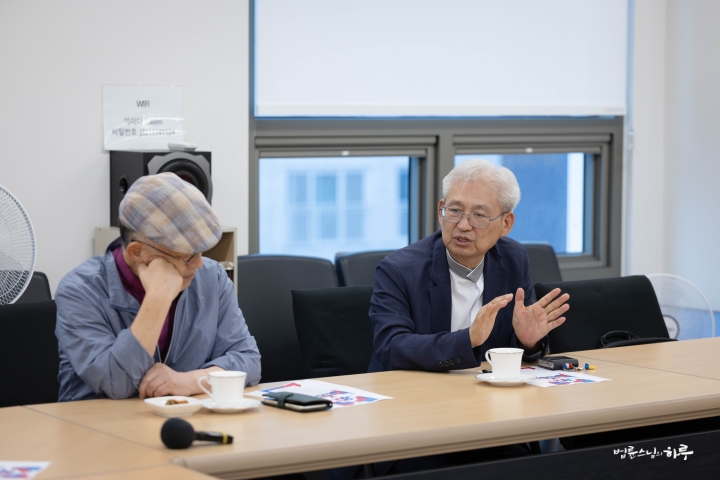
“There is no peace without interfaith dialogue. I sincerely hope that peace will last long in Sri Lanka through interfaith dialogue as well.”
Next, Islamic leader Firdous shared his reflections.
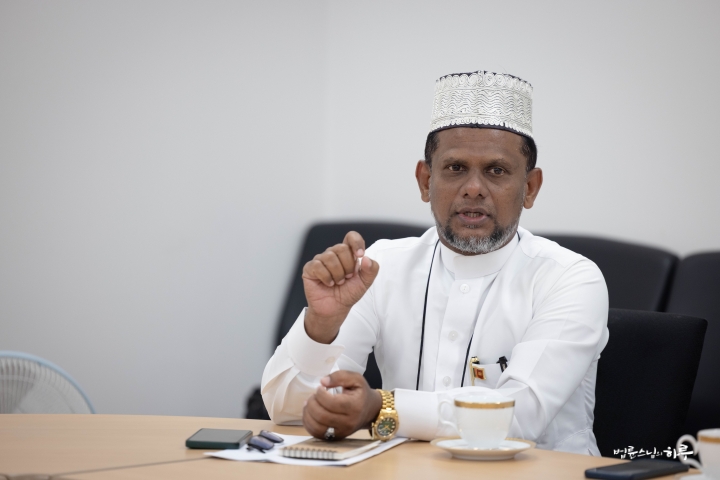
“I have heard well about the many achievements of the religious gathering. The foundation of our activities can be said to be the ‘spirit of integration.’ I pray that you will continue to work with this ‘spirit of integration’ and surely achieve peaceful unification between South and North Korea. I pray that all people in the South and North will live peaceful, free, and happy lives.”
Next, Hindu priest Darshaka shared his reflections.

“When I have occasion to visit foreign countries, I sometimes feel a sense of alienation from being in an unfamiliar place. However, during this visit to Korea, I felt warm and comfortable emotions as if I had come home. I deeply thank you for all the hospitality you have shown us. We have now become one family. We will pray for peace and harmony between South and North Korea. When we sincerely strive to achieve a purpose, I believe that God and the universe will surely help us. You are truly wonderful people, and God will help you too. We will always support you and be with you.”
Next, Bishop Park Kyung-jo of the Anglican Church of Korea shared his reflections.
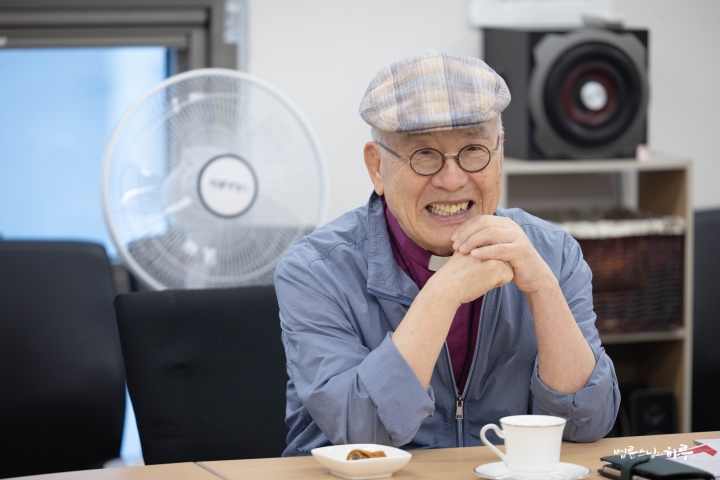
You Have Planted Seeds of Peace in Us
“I have received great inspiration through you. The path to reconciliation and peace may perhaps be contrary to human nature. That’s why wars and conflicts constantly occur in the world. Nevertheless, we have once again resolved that we must take this path. To walk this path, I believe religious people must return to their respective religious roots to gain new strength. Hearing the stories of how you have come together to accomplish great things, I too have made new resolutions and broadened my thinking. In a sense, I think you have planted seeds of peace in us. I hope those seeds will grow within us and someday bear various good fruits.”
Next, Venerable Pomnyun Sunim shared his reflections.
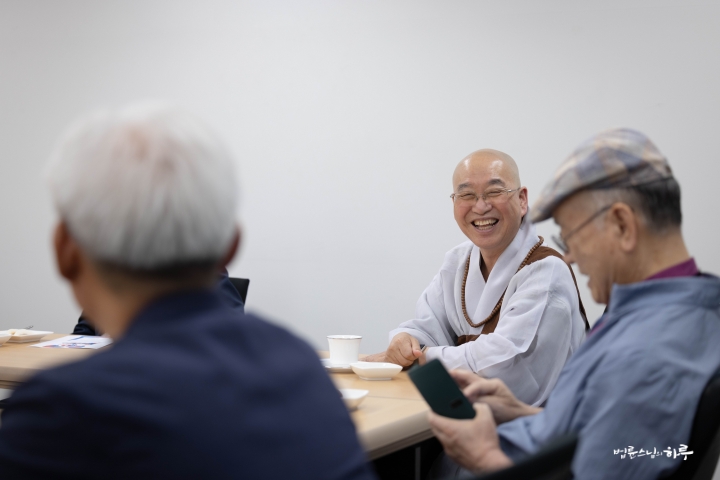
Based on Your Experience, We Will Work Harder for Peace Between South and North
“Thank you for accepting our invitation despite the long journey. When I visited Sri Lanka last year and participated in your gathering, listening to the stories of your activities, I thought there were many similarities with the ‘Religious Gathering for National Reconciliation and Peace’ that I participate in. Fortunately, the International Reconciliation Conference was held at Seoul National University this time, allowing us to invite you. Listening to your stories this time, I was deeply impressed to learn that you have successfully accomplished much more difficult tasks than I had known. I sincerely hope your activities will continue. Based on your valuable experience, I thought we too should make more efforts for peace between South and North. If there were any inconveniences during your stay here, I ask for your generous understanding.”
Next, Pastor Anura shared his reflections.
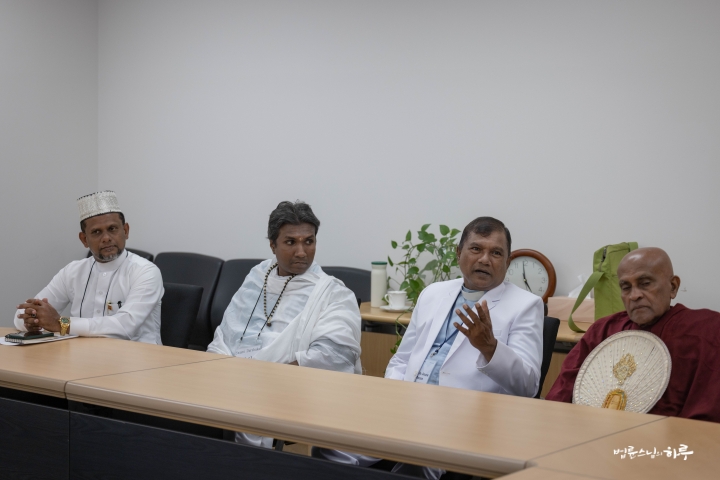
“This time, I felt that you have very good ideas and are extremely mature and hopeful. I hope you will continue to work steadily without giving up and achieve good results. Peace, harmony, and reconciliation are a long journey. I felt that many people are deeply committed, and I definitely felt the teamwork as well. I also deeply thank the staff who worked hard for us and those who volunteered in the kitchen.”
Next, Venerable Asaji shared his reflections.
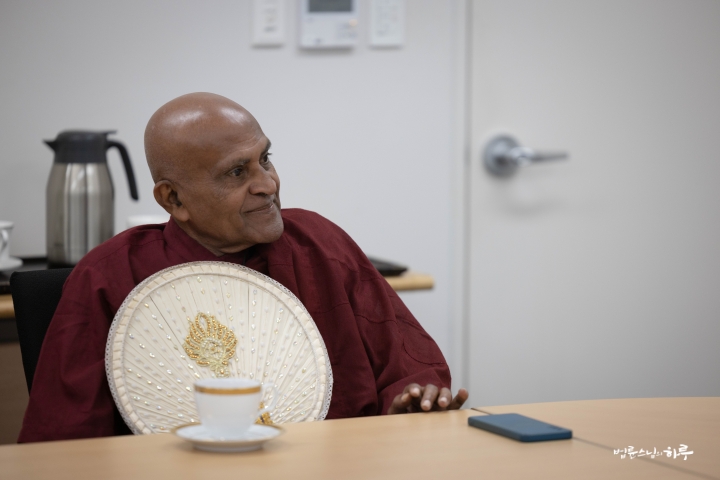
“We have spent very meaningful time over the past few days. Even though we will be physically apart in the future, I hope our hearts will always remain connected. I think the power will be truly great when South and North Korea become one. External forces may not want the South and North to unify. I sincerely send my blessings to all of you who are working to connect the hearts of the South and North. What I strongly felt this time is that various Buddhist organizations within Sri Lanka should also sincerely pray for the integration of South and North Korea. I believe that religious leaders can have more powerful influence than politicians.”
Finally, Gyoryeong Park Nam-soo, the chair of the religious gathering, shared his reflections.
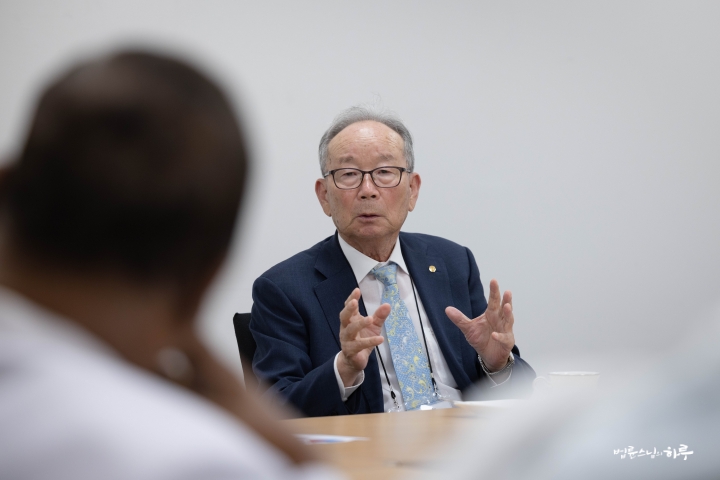
“I think what you have left behind during these three days here is greater than what you have received. Watching you, I learned ‘This is what an active heart is.’ I thought I was doing well in my own way, but after meeting you, I deeply reflected, ‘I have been so lazy.’ Thanks to you, I gained courage, so I have received much more from you. Your actions were teachings themselves. I will keep those teachings in my heart and continue to do my best in the peace movement and interfaith activities.”
With great applause, the journey of Asian interfaith dialogue for reconciliation and peace came to an end.
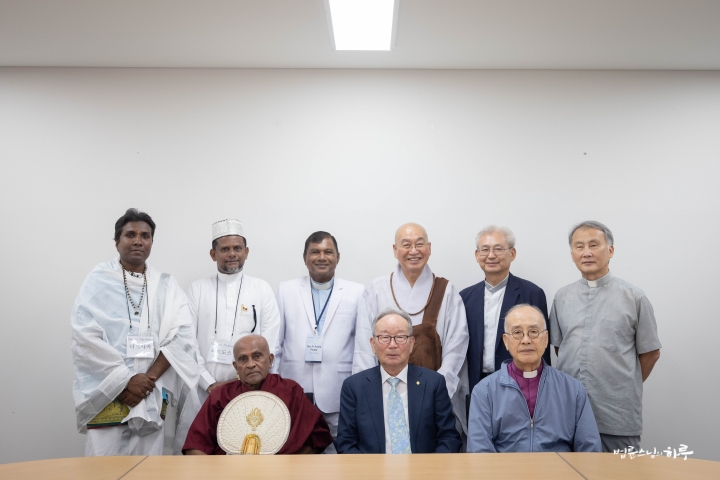
After taking a group photo together, everyone embraced each other, reaffirming the friendship built over the past days. They exchanged reluctant farewells, promising to meet again.
After all the religious leaders departed, the Sri Lankan religious leaders moved to their accommodation and went to bed. Holding the long and profound day in their hearts, everyone welcomed a peaceful night.
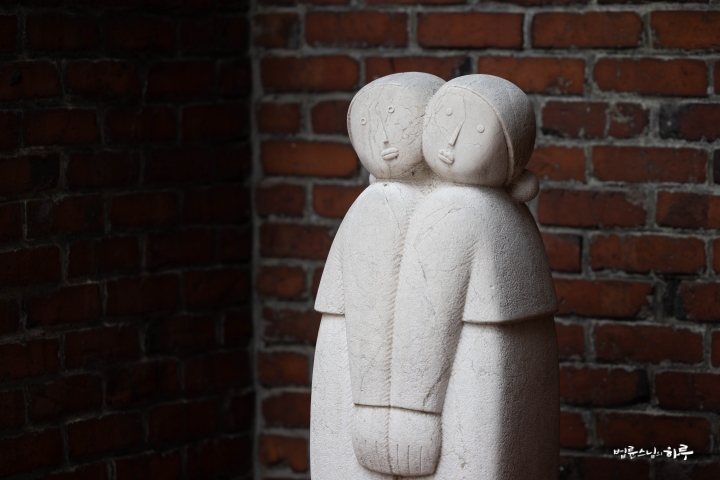
Tomorrow, Sunim will have back-to-back meetings all day with social figures visiting the Peace Foundation. Meanwhile, the Sri Lankan religious leaders will visit the Korea Modern History Museum, Gyeongbokgung Palace, and Insadong to broaden their understanding of Korean society.



